Permaculture companion plants for Tomato
| Image | Name | Data | Description | Actions |
|---|---|---|---|---|

|
Asparagus |
2-9
Full sun, Partial sun/shade
Moist
Light (sandy), Medium, Heavy (clay)
6.5-7.0
Evergreen
1-1.5m
1
Perennial
Herbs
Slow
12-18 inches rows, 6–8inches in row
Seed - direct sow, Seed - transplant, Division
16 weeks before last frost date
10-12 weeks, 1 week after last frost date
2-8 weeks
21-29°c (70-85°f)
true
Shoots, Stem
Sparrow grass
Spargel
Asparagaceae
Europe, Western asia, Afghanistan, Albania, Altay, Austria, Belarus, Bulgaria, Central European Rus, Corse, Czechoslovakia, France, Germany, Greece, Hungary, Iran, Kazakhstan, Krasnoyarsk, Krym, Lebanon-Syria, Mongolia, North Caucasus, Pakistan, Poland, Sicilia, South European Russi, Switzerland, Transcaucasus, Turkey, Turkey-in-Europe, Ukraine, West Siberia, Xinjiang
Alabama, Alberta, Algeria, Argentina Northeast, Argentina Northwest, Argentina South, Arizona, Arkansas, Baltic States, Bangladesh, Belgium, Bolivia, British Columbia, California, Colorado, Connecticut, Costa Rica, Cyprus, Delaware, Denmark, District of Columbia, East European Russia, East Himalaya, Ethiopia, Finland, Florida, Georgia, Great Britain, Idaho, Illinois, Indiana, Iowa, Ireland, Kansas, Kentucky, Labrador, Louisiana, Madagascar, Maine, Manitoba, Marianas, Maryland, Massachusetts, Mauritius, Mexico Central, Mexico Gulf, Mexico Northeast, Mexico Southeast, Mexico Southwest, Michigan, Minnesota, Mississippi, Missouri, Montana, Morocco, Nebraska, Netherlands, Nevada, New Brunswick, New Hampshire, New Jersey, New Mexico, New South Wales, New York, New Zealand North, New Zealand South, Newfoundland, North Carolina, North Dakota, North European Russi, Northwest European R, Norway, Nova Scotia, Ohio, Oklahoma, Ontario, Oregon, Pennsylvania, Portugal, Prince Edward I., Queensland, Québec, Rhode I., Réunion, Sardegna, Saskatchewan, Seychelles, Solomon Is., South Australia, South Carolina, South Dakota, Spain, Sweden, Tasmania, Tennessee, Texas, Trinidad-Tobago, Tunisia, Uruguay, Utah, Vermont, Victoria, Virginia, Washington, West Himalaya, West Virginia, Western Australia, Wisconsin, Wyoming
True
https://en.wikipedia.org/wiki/asparagus
https://pfaf.org/user/plant.aspx?latinname=asparagus officinalis
https://powo.science.kew.org/taxon/urn:lsid:ipni.org:names:531229-1
Fasciculated
3-8inches
8-12 weeks before last frost
Toxic fruits
Coffee
Pest control
|
Asparagus officinalis is a plant native to most of Europe, northern Africa, and western Asia. It is a herbaceous perennial plant that typically grows to around 0.5 to 1.5 meters in height, with slender stems and feathery leaves. The stems are typically green, but some varieties can have purple or white stems. The plant produces small, fragrant white or pink flowers in the spring, which give way to red berries in the fall, which are toxic to humans. Asparagus is a fast-growing plant that prefers well-draining, fertile soil and full sun exposure. It can grow in saline soils where other plants to do not grow. A soil pH below 6 is possible but best is to adjust to 6.5-7.0. It can be grown from seed or from crowns, and typically takes 2-3 years to reach maturity and begin producing edible shoots, which can be harvested for around 8-12 weeks each season. In cold climates, asparagus is winter hardy and can be left in the ground to overwinter. In warmer climates, it may need to be dug up and stored in a cool, dry place during the winter months. The edible shoots of asparagus can be harvested in the spring and early summer. They can be eaten raw or cooked, and have a delicate, slightly sweet flavor. The shoots can be stored in the refrigerator for a few days, but are best used fresh. Asparagus is a low-calorie, nutrient-dense vegetable, with high levels of vitamins A, C, and K, as well as folate and fiber. In addition to its use as a food, asparagus has a number of other uses. It is often used medicinally to treat a variety of conditions, including digestive disorders and urinary tract infections. The plant's leaves and stems can be used as mulch or compost, and the roots can help to fix nitrogen in the soil, making it useful for improving soil health. Asparagus has also been used as a weaving material and as a building material, due to its strength and durability. Asparagus is a valuable plant for wildlife, providing food and habitat for a variety of animals. The plant's flowers attract bees and other pollinators, and the berries are eaten by birds and small mammals. Asparagus is a good companion plant to the Tomato since it repels some harmful root nematodes for Tomatoes and Tomatoes repel the asparagus beetle. |
Show
Edit |
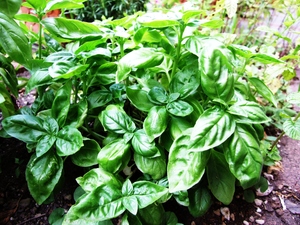
|
Basil |
5-10
Annual, Perennial
Full sun
Moist
Light (sandy), Medium
0.5
Herbs
true
Leaves, Seed
Seed - direct sow
https://en.wikipedia.org/wiki/Basil
Fast
Common basil, Thai basil, Tropical basil
Lamiaceae or labiatae
Basilikum
https://pfaf.org/User/Plant.aspx?LatinName=Ocimum basilicum
Start indoors from late february to mid-summer
Can be grown in containers
1.1
Andaman Is., Assam, Bangladesh, Bismarck Archipelago, Borneo, Cambodia, China South-Central, China Southeast, East Himalaya, India, Jawa, Laos, Lesser Sunda Is., Malaya, Maluku, Myanmar, Nepal, New Guinea, Nicobar Is., Philippines, Queensland, Sri Lanka, Sulawesi, Sumatera, Taiwan, Thailand, Vietnam, West Himalaya, Western Australia
Angola, Bahamas, Benin, Bolivia, Brazil Southeast, Bulgaria, Burkina, Burundi, Cameroon, Canary Is., Cape Provinces, Cape Verde, Caroline Is., Cayman Is., Central African Repu, Chad, Colombia, Comoros, Congo, Cook Is., Cuba, Dominican Republic, East Aegean Is., Ecuador, El Salvador, Eritrea, Ethiopia, Fiji, Gabon, Gambia, Ghana, Gilbert Is., Guatemala, Guinea, Guinea-Bissau, Gulf of Guinea Is., Haiti, Hawaii, Honduras, Illinois, Ivory Coast, Jamaica, Kazakhstan, Kenya, Laccadive Is., Leeward Is., Liberia, Line Is., Madagascar, Malawi, Maldives, Mali, Marianas, Marquesas, Marshall Is., Mexico Central, Mexico Gulf, Mexico Northeast, Mexico Northwest, Mexico Southeast, Mexico Southwest, Mongolia, Mozambique, Nauru, New Caledonia, New York, Nicaragua, Niger, Nigeria, Niue, Oman, Panamá, Primorye, Puerto Rico, Romania, Samoa, Senegal, Sierra Leone, Society Is., South Australia, South European Russi, Sudan, Tanzania, Tokelau-Manihiki, Tonga, Trinidad-Tobago, Tuamotu, Uganda, Ukraine, Venezuela, Venezuelan Antilles, Wallis-Futuna Is., Windward Is., Xinjiang, Zambia, Zaïre, Zimbabwe
After last frost date
15cm
https://powo.science.kew.org/taxon/urn:lsid:ipni.org:names:452874-1
Condiment, Drink, Tea
Essential Oil, Strewing, Fragrance
|
Basil (Ocimum basilicum) is a herb native to tropical regions of Asia and Africa. It is known for its fragrant, green leaves and small, white flowers. The leaves are typically oval-shaped and have a glossy texture. The stem is typically square-shaped and can grow up to 24 inches tall. Basil is a fast-growing plant that prefers full sun and well-drained soil. In colder climates, it is typically grown as an annual, as it is not winter hardy. To cultivate basil successfully, a grower should water it regularly and provide adequate drainage. Removing the last pair of leaves encourages branching and growth. Basil is often differentiated from other plants by its distinctive aroma, which is used in a wide variety of dishes, including pesto, soups, and salads. The leaves, flowers, and stems of the basil plant are all edible, and can be stored by drying or freezing. In addition to its culinary uses, basil has a number of other uses. It has been used medicinally as an anti-inflammatory and to improve digestion. It is also known to attract bees and other pollinators, making it valuable for gardens. |
Show
Edit |
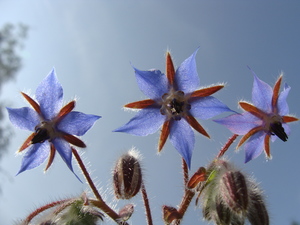
|
Borage |
6-9
Annual
Full sun, Partial sun/shade
Dry, Moist
Light (sandy), Medium, Heavy (clay)
0.6
Herbs
Flowers, Leaves
Seed - direct sow
https://en.wikipedia.org/wiki/Borage
Medium
Common borage, Cool-tankard, Tailwort, Starflower
Boraginaceae
Borretsch
60cm
5-15 days
21°c (70°f)
Oil, Colouring, Tea
https://pfaf.org/User/Plant.aspx?LatinName=Borago officinalis
Borago
5
-2
Algeria, Baleares, Corse, France, Greece, Italy, Kriti, Libya, Morocco, Portugal, Sardegna, Sicilia, Spain, Tunisia, Yugoslavia
Alaska, Alberta, Altay, Argentina Northeast, Argentina Northwest, Argentina South, Austria, Azores, Baltic States, Belgium, Bolivia, British Columbia, Buryatiya, California, Canary Is., Central European Rus, Chile Central, Colombia, Connecticut, Cuba, Cyprus, Czechoslovakia, District of Columbia, Dominican Republic, East Aegean Is., East European Russia, Ecuador, Germany, Great Britain, Guatemala, Haiti, Honduras, Hungary, Illinois, Irkutsk, Jawa, Kamchatka, Kazakhstan, Kirgizstan, Krym, Kuril Is., Lebanon-Syria, Madeira, Maine, Manitoba, Massachusetts, Mexico Central, Mexico Southwest, Michigan, Minnesota, Montana, Netherlands, New Brunswick, New Hampshire, New Jersey, New York, New Zealand North, New Zealand South, Newfoundland, North Caucasus, North Dakota, North European Russi, Northwest European R, Nova Scotia, Ohio, Ontario, Oregon, Pennsylvania, Peru, Poland, Primorye, Prince Edward I., Puerto Rico, Québec, Rhode I., Romania, Sakhalin, Saskatchewan, South European Russi, Switzerland, Tasmania, Tubuai Is., Turkey, Turkey-in-Europe, Turkmenistan, Ukraine, Uruguay, Utah, Vermont, Virginia, Washington, West Siberia, West Virginia, Wisconsin
At last frost
0.3
https://powo.science.kew.org/taxon/urn:lsid:ipni.org:names:113618-1
Dye, oil, Dynamic accumulator
true
|
Borage, also known as Borago officinalis, is a herb native to the Mediterranean region. It is a hairy, annual herb that grows to a height of about 60 cm, with blue, star-shaped flowers and large hairy leaves. The plant is easily differentiated from similar plants by its hairy stems and leaves, and its bright blue flowers. Borage prefers well-drained soil and full sun, and grows best in warm temperatures. It is a fast-growing plant, and can be easily cultivated by direct sowing or transplanting seedlings. Borage is not winter hardy, and should be grown as an annual in most climates. The leaves and flowers of borage are edible, and can be used in salads, soups, and other dishes. The leaves have a cucumber-like flavor, while the flowers are slightly sweet. The edible parts of the plant can be stored by freezing or drying. Borage has several medicinal uses, and has been used traditionally to treat a variety of ailments, including respiratory problems, skin irritation, and anxiety. It is also a good source of nutrients, including calcium, potassium, and vitamin C. In addition to its medicinal uses, borage has value as a companion plant in the garden. It attracts pollinators, such as bees and butterflies, and can be used as a natural pest deterrent. #### Propagation Direct sow early spring when temperatures reach 21°C (70°F). Best sown directly, as borage develops a delicate taproot. #### Links [Borage @ West Coast Seeds](https://www.westcoastseeds.com/products/borage) |
Show
Edit |

|
Carrot |
3-10
Biennial
Full sun
Moist
Light (sandy), Medium, Heavy (clay)
1.2
Leaves, Root
Apiaceae or Umbelliferae
Möhre, Karotte
https://pfaf.org/User/Plant.aspx?LatinName=Daucus carota sativus
Afghanistan, Albania, Algeria, Austria, Azores, Baleares, Baltic States, Belarus, Belgium, Bulgaria, Canary Is., Cape Verde, Central European Rus, China South-Central, China Southeast, Corse, Cyprus, Czechoslovakia, Denmark, East Aegean Is., East European Russia, Eritrea, Ethiopia, France, Germany, Great Britain, Greece, Hungary, Iran, Iraq, Ireland, Italy, Kazakhstan, Kirgizstan, Kriti, Krym, Lebanon-Syria, Libya, Madeira, Morocco, Nepal, Netherlands, North Caucasus, Northwest European R, Norway, Pakistan, Palestine, Poland, Portugal, Romania, Sardegna, Sicilia, South European Russi, Spain, Sweden, Switzerland, Tadzhikistan, Transcaucasus, Tunisia, Turkey, Turkey-in-Europe, Turkmenistan, Ukraine, Uzbekistan, West Himalaya, Yugoslavia
Alabama, Amsterdam-St.Paul Is, Andaman Is., Angola, Argentina Northeast, Argentina Northwest, Argentina South, Arizona, Arkansas, Bangladesh, Brazil South, British Columbia, California, Cape Provinces, Chile Central, Chile South, China North-Central, Colorado, Connecticut, Costa Rica, Cuba, Delaware, Desventurados Is., District of Columbia, Dominican Republic, Easter Is., Ecuador, El Salvador, Finland, Florida, Georgia, Guatemala, Hainan, Haiti, Iceland, Idaho, Illinois, India, Indiana, Inner Mongolia, Iowa, Jamaica, Japan, Jawa, Kansas, Kentucky, Kermadec Is., Korea, Labrador, Leeward Is., Louisiana, Maine, Manchuria, Manitoba, Marianas, Marshall Is., Maryland, Massachusetts, Mauritius, Mexico Central, Mexico Northeast, Michigan, Minnesota, Mississippi, Missouri, Mongolia, Montana, Myanmar, Nebraska, Nevada, New Brunswick, New Hampshire, New Jersey, New Mexico, New York, New Zealand North, New Zealand South, Newfoundland, Nicobar Is., North Carolina, North Dakota, North European Russi, Northern Provinces, Nova Scotia, Ohio, Oklahoma, Ontario, Oregon, Pennsylvania, Peru, Primorye, Prince Edward I., Puerto Rico, Qinghai, Québec, Rhode I., Rodrigues, Réunion, Saskatchewan, South Carolina, South Dakota, Sri Lanka, Sudan, Tasmania, Tennessee, Texas, Tibet, Trinidad-Tobago, Uruguay, Utah, Vermont, Vietnam, Virginia, Washington, West Siberia, West Virginia, Wisconsin, Wyoming, Xinjiang
0.20
https://powo.science.kew.org/taxon/urn:lsid:ipni.org:names:841063-1
Coffee, Colouring, Condiment
Alcohol, Dye, Essential Oil, Dynamic accumulator, Fragrance
true
|
Carrot (Daucus carota sativus) is a type of root vegetable that is native to Europe and Asia. It belongs to the family Apiaceae, which includes around 300 species of plants. Carrots are a popular crop, known for their sweet, crunchy roots and vibrant orange color. The plant has a tall, slender growth habit and can reach a height of up to 2-3 feet. The leaves are green and feathery, and the flowers are small and white or purple in color. To grow carrots successfully, it is important to choose a location with well-drained, sandy soil and full sun. The plant prefers cool temperatures and should be protected from frost. Carrots can also be grown in containers, and will benefit from regular watering and fertilization. The plant is relatively easy to grow and requires little maintenance, but can be susceptible to pests and diseases, such as carrot fly and root rot. Carrots are a valuable source of vitamins and minerals, and are used in a variety of dishes, including soups, stews, and salads. The roots can be eaten fresh or cooked, and can be stored in the refrigerator for several weeks. In addition to their culinary uses, carrots have a number of medicinal properties, and have been used to treat a variety of ailments, including indigestion, constipation, and respiratory disorders. Carrots are also a valuable food source for many types of wildlife, including birds, insects, and small mammals. The flowers attract bees and other pollinators, and the roots are eaten by animals such as rabbits and deer. |
Show
Edit |
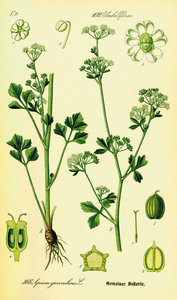
|
Celery |
5-9
Partial sun/shade
Moist
Light (sandy), Medium, Heavy (clay)
0.6
0.5
Annual, Biennial
Herbs
true
Leaves, Root, Seed
Ajwain-ka-patta (indian)
Sellerie
Apiaceae or umbelliferae
Argentina Northeast, Bolivia, Brazil South, Brazil Southeast, Paraguay, Uruguay
https://en.wikipedia.org/wiki/Celery
https://pfaf.org/User/Plant.aspx?LatinName=Apium graveolens
https://powo.science.kew.org/taxon/urn:lsid:ipni.org:names:16467-2
Condiment
Essential Oil, Fragrance
|
Show
Edit |
|

|
Chives |
3-12
Full sun, Partial sun/shade
Moist
Light (sandy), Medium, Heavy (clay)
6.0-7.0
0.3
0.45
Perennial
Herbs
Medium
8-12inches
Seed - direct sow, Seed - transplant, Division
4-6 weeks before last frost
14-21 days
21°c (70°f)
antifungal, Dynamic accumulator, Ground cover, Fragrance
true
Flowers, Leaves, Root
Wild chives, Flowering onion
Schnittlauch
Alliaceae
Allium
Afghanistan, Alaska, Albania, Alberta, Altay, Austria, Baltic States, Belarus, British Columbia, Bulgaria, Buryatiya, Central European Rus, Chita, Colorado, Connecticut, Corse, Czechoslovakia, Denmark, East European Russia, Finland, France, Germany, Great Britain, Greece, Idaho, Iran, Iraq, Irkutsk, Italy, Japan, Kamchatka, Kazakhstan, Khabarovsk, Korea, Krasnoyarsk, Kuril Is., Labrador, Magadan, Maine, Manitoba, Massachusetts, Michigan, Minnesota, Mongolia, Montana, Netherlands, New Brunswick, New Hampshire, New Jersey, New York, North Caucasus, North European Russi, Northwest European R, Northwest Territorie, Norway, Nova Scotia, Nunavut, Ohio, Ontario, Oregon, Pakistan, Pennsylvania, Poland, Portugal, Primorye, Prince Edward I., Québec, Rhode I., Romania, Sakhalin, Saskatchewan, South European Russi, Spain, Sweden, Switzerland, Tadzhikistan, Transcaucasus, Turkey, Tuva, Ukraine, Vermont, Washington, West Himalaya, West Siberia, Wisconsin, Wyoming, Xinjiang, Yakutskiya, Yugoslavia, Yukon
Argentina South, Azores, Belgium, Comoros, Cuba, Dominican Republic, Falkland Is., Haiti, Illinois, Ireland, Jamaica, Maryland, Newfoundland, Seychelles, Trinidad-Tobago
https://en.wikipedia.org/wiki/Chives
https://pfaf.org/User/Plant.aspx?LatinName=Allium schoenoprasum
https://powo.science.kew.org/taxon/urn:lsid:ipni.org:names:528823-1
|
Chives (Allium schoenoprasum) are a bulb-forming herbaceous perennial plants that belong to the same family as onions, garlic, and leeks. They are native to Europe, Asia, and North America, and are commonly grown in gardens for their delicate onion flavor and attractive purple flowers. Chives are easy to grow and require little maintenance. They can be grown in pots or containers, or directly in the ground. The plants have thin, hollow leaves that grow in tight clumps and reach a height of around 12-20 inches (30-50 cm). The bulbs are slender, conical, 2–3 cm (3⁄4–1 1⁄4 in) long and 1 cm (1⁄2 in) broad, and grow in dense clusters from the roots. The scapes (or stems) are hollow and tubular, up to 50 cm (20 in) long and 2–3 mm (1⁄16–1⁄8 in) across, with a soft texture, although, prior to the emergence of a flower, they may appear stiffer than usual. The grass-like leaves, which are shorter than the scapes, are also hollow and tubular, or terete, (round in cross-section) which distinguishes it at a glance from garlic chives (Allium tuberosum). The flowers are pale purple, and star-shaped with six petals, 1–2 cm (1⁄2–3⁄4 in) wide, and produced in a dense inflorescence of 10-30 together; before opening, the inflorescence is surrounded by a papery bract. The seeds are produced in a small, three-valved capsule, maturing in summer. The herb flowers from April to May in the southern parts of its habitat zones and in June in the northern parts. Chives are often used as a seasoning in a variety of dishes, including soups, omelets, and dips. They can also be added to melted butter to make a simple but flavorful sauce for steamed vegetables. Chives are low in calories and a good source of vitamin C, making them a healthy addition to any diet. |
Show
Edit |
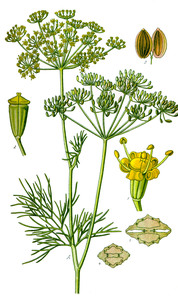
|
Anethum graveolens |
2-11
Full sun
Moist
Light (sandy), Medium
0.8
Annual
Herbs
Medium
15cm x 30cm
Essential Oil, Pest control, Fragrance
true
Leaves, Seed
Condiment, Tea
Dill
Apiaceae or umbelliferae
Algeria, Chad, Cyprus, Gulf States, Iran, Lebanon-Syria, Libya, Morocco, Oman, Saudi Arabia, Tunisia
Afghanistan, Alabama, Albania, Alberta, Altay, Andaman Is., Angola, Argentina Northeast, Arizona, Arkansas, Assam, Austria, Azores, Bahamas, Baleares, Baltic States, Bangladesh, Belarus, Belgium, Brazil South, Brazil Southeast, British Columbia, Bulgaria, California, Cameroon, Canary Is., Cape Verde, Cayman Is., Central European Rus, China North-Central, China South-Central, China Southeast, Connecticut, Costa Rica, Cuba, Czechoslovakia, Delaware, Denmark, Dominican Republic, East Aegean Is., East European Russia, East Himalaya, Ecuador, Eritrea, Ethiopia, Finland, France, Ghana, Great Britain, Greece, Guatemala, Haiti, Hawaii, Hungary, Illinois, India, Indiana, Iowa, Iraq, Italy, Jamaica, Kansas, Kazakhstan, Kentucky, Kenya, Kriti, Krym, Laos, Leeward Is., Louisiana, Madeira, Maine, Manitoba, Maryland, Massachusetts, Michigan, Minnesota, Missouri, Mongolia, Montana, Mozambique, Nebraska, Nepal, Netherlands, New Jersey, New York, Nicobar Is., Niger, Nigeria, North Carolina, North Dakota, Northwest European R, Norway, Ohio, Oklahoma, Ontario, Oregon, Pakistan, Palestine, Pennsylvania, Peru, Portugal, Primorye, Puerto Rico, Québec, Rhode I., Romania, Saskatchewan, Sicilia, Somalia, South Dakota, South European Russi, Spain, Sudan, Sweden, Switzerland, Tadzhikistan, Tanzania, Texas, Thailand, Transcaucasus, Trinidad-Tobago, Turkey, Turkey-in-Europe, Ukraine, Uzbekistan, Vietnam, Virginia, Wake I., Washington, West Virginia, Windward Is., Wisconsin, Yugoslavia
https://en.wikipedia.org/wiki/Dill
https://pfaf.org/User/Plant.aspx?LatinName=Anethum graveolens
https://powo.science.kew.org/taxon/urn:lsid:ipni.org:names:837530-1
Dill
|
Dill (Anethum graveolens) is a plant native to the eastern Mediterranean region and West Asia. It is an annual herb that grows to a height of about 1-2 feet and has delicate, feathery leaves. The plant has small yellow flowers that bloom in the summer. Dill is a popular herb in many cuisines, especially in European and Middle Eastern dishes. It is used to flavor soups, stews, fish, and pickles. The leaves and seeds of dill are both edible and can be used fresh or dried. The seeds have a more pungent flavor than the leaves and are often used in pickling. Dill can be stored by drying or freezing the leaves and seeds. Dill prefers full sun and well-drained soil. It is easy to grow and can be started from seed or from transplants. Dill is not winter hardy and will die off in the winter. In addition to its culinary uses, dill has been used medicinally to aid in digestion and to reduce inflammation. It has also been used as a natural insect repellent. The plant is attractive to many types of beneficial insects, making it a valuable addition to any garden. |
Show
Edit |
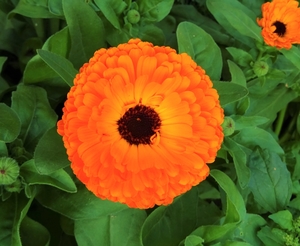
|
Pot marigold |
2-11
Full sun, Partial sun/shade
Moist
Light (sandy), Medium, Heavy (clay)
5.5-7.0
0.6
0.3
Annual
Medium
15cm
6-14 days
21°c (70°f)
60
Compost, Cosmetic, Dye, Essential Oil, Weather forecasting, Dynamic accumulator, Fragrance
Flowers, Leaves
Calendula, Common marigold, Scotch marigold, Ruddles
Ringelblume
Asteraceae or compositae
Spain
Afghanistan, Albania, Argentina Northeast, Argentina Northwest, Argentina South, Assam, Austria, Azores, Baleares, Baltic States, Belarus, Belgium, Bolivia, Borneo, British Columbia, Bulgaria, California, Canary Is., Central European Rus, Chatham Is., Chile Central, Chile North, Chile South, China North-Central, China South-Central, China Southeast, Colombia, Connecticut, Cook Is., Corse, Costa Rica, Cyprus, Czechoslovakia, East Aegean Is., East European Russia, East Himalaya, Ecuador, Ethiopia, France, Germany, Great Britain, Greece, Guatemala, Hainan, Honduras, Hungary, India, Iraq, Ireland, Italy, Jawa, Juan Fernández Is., Kazakhstan, Kriti, Krym, Lebanon-Syria, Lesser Sunda Is., Libya, Madeira, Maine, Malaya, Manchuria, Massachusetts, Mauritius, Mexico Southeast, Michigan, Morocco, Myanmar, Nepal, Netherlands, New Hampshire, New South Wales, New York, New Zealand North, New Zealand South, Newfoundland, North Caucasus, North European Russi, Northern Territory, Northwest European R, Norway, Nova Scotia, Ohio, Ontario, Pakistan, Paraguay, Pennsylvania, Peru, Philippines, Poland, Portugal, Primorye, Qinghai, Queensland, Québec, Romania, Sardegna, Sicilia, South Australia, South European Russi, Sulawesi, Sumatera, Sweden, Switzerland, Tadzhikistan, Taiwan, Tasmania, Tibet, Transcaucasus, Trinidad-Tobago, Turkey, Turkmenistan, Ukraine, Uruguay, Uzbekistan, Victoria, Vietnam, Washington, Western Australia, Wisconsin, Xinjiang, Yugoslavia
https://en.wikipedia.org/wiki/Calendula_officinalis
https://pfaf.org/User/Plant.aspx?LatinName=Calendula officinalis
https://powo.science.kew.org/taxon/urn:lsid:ipni.org:names:187894-1
4.6
Colouring, Tea
true
|
The pot marigold, also known as Calendula officinalis, is a flowering plant probably native to southwestern Asia, western Europe, and the Mediterranean region, however, its long cultivation history makes its precise origin unknown. It is a herbaceous annual plant that typically grows to be about 12-18 inches tall, with hairy stems and leaves. The leaves are lance-shaped, with a hairy surface, and the flowers can range in colour from white through yellow and orange to red and even pink. In terms of growing conditions, the pot marigold prefers well-drained soil and full sun, although it can tolerate partial shade. It is winter hardy, but may not flower as profusely in colder climates. To cultivate it successfully, a grower should plant pot marigold seeds directly in the ground after the last frost of the season. The pot marigold has a number of uses, both culinary and medicinal. The flowers are edible and can be used to add color and flavor to salads and other dishes. The petals can also be dried and used to make tea. In terms of medicinal uses, the plant has been used for centuries to treat a variety of ailments, including wounds, infections, and skin irritation. The pot marigold is also attractive to a variety of pollinators, making it a valuable plant for attracting beneficial insects to the garden. Overall, the pot marigold is a versatile and easy-to-grow plant that is well-suited to a variety of garden settings. ### Propagation - Direct sow Direct sow in spring when light frost is still possible. Can be sown until early summer for fall blooms. ### Propagation - Transplant Sow indoors in late winter, transplant outside when risk of heavy frost has passed. #### Links [Calendula @ West Coast Seeds](https://www.westcoastseeds.com/products/zeolights-organic) |
Show
Edit |
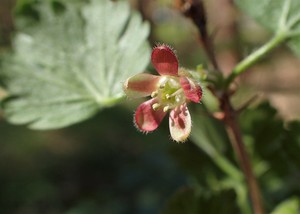
|
Gooseberry |
4-8
Perennial
Full sun, Partial sun/shade
Moist
Light (sandy), Medium, Heavy (clay)
Deciduous
1.2
Shrubs
Cosmetic
true
Fruit, Leaves
https://en.wikipedia.org/wiki/Ribes_uva-crispa
Medium
European gooseberry, american gooseberry, cu li, egres, fuge, gigadze, groseille a maquareau, groseillier, grosella blanca, grosellero, kikerberi, kryhovnik, maru suguri, stachelbeere, uva spina
Grossulariaceae
true
https://pfaf.org/User/Plant.aspx?LatinName=Ribes uva-crispa
Albania, Algeria, Austria, Belgium, Bulgaria, Czechoslovakia, France, Germany, Greece, Hungary, Iran, Italy, Kriti, Morocco, Netherlands, Poland, Romania, Spain, Switzerland, Transcaucasus, Turkey, Ukraine, Yugoslavia
Baltic States, Belarus, Central European Rus, China North-Central, Connecticut, Delaware, Denmark, East European Russia, Falkland Is., Finland, Great Britain, Iceland, Indiana, Iowa, Ireland, Japan, Kentucky, Korea, Kuril Is., Labrador, Maine, Manchuria, Maryland, Massachusetts, New Hampshire, New Jersey, New York, Newfoundland, North Dakota, North European Russi, Ohio, Ontario, Pennsylvania, Québec, South Dakota, South European Russi, Sweden, Tadzhikistan, Turkey-in-Europe, Vermont, West Virginia, Wisconsin, Xinjiang
https://powo.science.kew.org/taxon/urn:lsid:ipni.org:names:793052-1
1
|
The gooseberry is a plant native to Europe, northern Africa, and western Asia. It is a shrub that typically grows to 1-2 meters in height, with spiny stems and green leaves that are oval in shape. The plant produces small green or red berries that are edible. The gooseberry plant prefers to grow in full sun and well-draining soil. It can tolerate a variety of soil types but prefers a neutral to slightly acidic pH. Growers may need to prune the plant regularly to maintain its shape and encourage fruit production. The plant is winter hardy, meaning it can withstand cold temperatures without damage. The berries of the gooseberry plant are edible and can be eaten fresh or used in cooking. They are high in vitamin C and can be stored in the refrigerator for several days after harvest. The plant has a number of uses, including medicinal uses such as treating diarrhea and dysentery. The plant's leaves can also be used as a natural insect repellent. In addition to its uses for humans, the gooseberry plant is also valuable for wildlife. The plant provides food and shelter for a variety of animals, including birds, insects, and small mammals. The plant's spiny stems also provide protection for nesting birds. Overall, the gooseberry is a versatile and valuable plant for gardeners and farmers. |
Show
Edit |
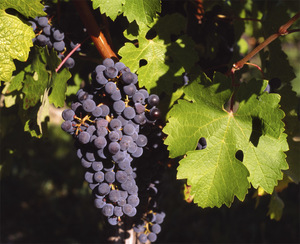
|
Common Grape Vine |
6-10
Perennial
Full sun, Partial sun/shade
Dry, Moist
Light (sandy), Medium, Heavy (clay)
Deciduous
15-32m
Vines
True
Flowers, Fruit, Leaves, Seed
Seed - direct sow, Cuttings
https://en.wikipedia.org/wiki/Vitis_vinifera
Fast
Wine grape, Purpleleaf grape, Common grape, Angur, Diva loza, Grozde yagorida, Tumpeang ba'y chu, Uva, Vid, Vigne, Vino, Weinrebe, Aanab, Ainab, Aitoviiniköynnös, Lehti, Angoor, Angur, Blad från vinranka, Bortermo szolo levél, Cognac oil, Common grape vine, Dakh, Darakh, Drakh, Draksa, Draksh, Draksha, Draksha kottai, Draksha pondu, Drakshai, Drakya, Dry grapes, Drak?a (fruit), European grape, Feuille de vigne rouge, Folha de videira, Frunze de vita-de-vie, Gostani, Gostoni, Grape, Grape seeds oligomeric proanthocyanidins, Grape vine, Grapevine, Grapevine leaf, Kashmish, Kishmish, Kottai drakshai, Lambrusca, Lambrusque, Lie de vin, List vinica, List vinske trte, Lisc winorosli wlasciwej, Maneka, Maweez munaqqa, Maweezak kohi, Munaca, Munaqqa, Munkka, Munthringya, M?dvika, Parra, Raisins, Rote weinrebenblätter, Rød vinranke, Blad, Tikruju vynmedžiu lapai, Vid, Hoja de, Vigne, Vigne rouge, Vigne vinifère, Viinapuu lehed, Vinblad, Vine, Vinho, Vino, Vite, Foglia, Vitis vinifera, Flos, Vitis viniferae folium, Vínviðarlauf, Weinrebe, Werqa tad-dielja, Wijnstokblad, Wine, Wine grape, Zabeeb-ul-jabal, Cervený list vinné révy, Ista vinkoka lapas
Vitaceae
Weintraube
Oil
https://pfaf.org/user/plant.aspx?latinname=Vitis+Vinifera
Southern Europe, Central Europe, Southwestern asia , Albania, Austria, Bulgaria, Corse, Cyprus, Czechoslovakia, France, Germany, Greece, Hungary, Iran, Iraq, Italy, Kirgizstan, Krym, Lebanon-Syria, North Caucasus, Palestine, Romania, Sardegna, Sicilia, Switzerland, Tadzhikistan, Transcaucasus, Turkey, Turkey-in-Europe, Turkmenistan, Ukraine, Uzbekistan, Yugoslavia
4.3-8.6
Tap
0.6-6m
8feet
6 weeks
20°c (69°f)
12 months
False
Druif
Vindrue
Afghanistan, Algeria, Angola, Argentina Northeast, Azores, Baleares, Bangladesh, Belgium, British Columbia, California, Canary Is., Cape Verde, Caroline Is., Chad, China North-Central, China South-Central, China Southeast, East Aegean Is., East European Russia, East Himalaya, Easter Is., Ecuador, Eritrea, Ethiopia, Gulf of Guinea Is., Idaho, India, Kazakhstan, Korea, Kriti, Laos, Libya, Madeira, Massachusetts, Morocco, New Hampshire, New York, New Zealand North, Oregon, Pakistan, Pennsylvania, Peru, Poland, Portugal, South European Russi, Spain, Tibet, Trinidad-Tobago, Tunisia, Vietnam, Washington, West Himalaya
https://powo.science.kew.org/taxon/urn:lsid:ipni.org:names:30478388-2
1
|
This is the common grape which has a lot of varieties but only a few are grown (commercially). Common Grape Vine (Vitis vinifera) is a species of grapevine native to the Mediterranean region, central Europe, and southwestern Asia. It is a woody perennial vine that grows to a length of 20-30 feet when supported by a trellis or other structure. The leaves are dark green and palmately lobed, with five to nine leaflets. The flowers are small and greenish-white, and are produced in clusters. The fruit is a berry, typically blue or purple in color, and is edible. In terms of growth and cultivation, Common Grape Vine prefers full sun and well-draining soil. It can be grown from cuttings or from grape seeds, and should be trained to a trellis or other support structure. In order to produce fruit, the plant must be cross-pollinated with another grapevine of a different variety. The fruit is typically harvested in the late summer or early fall. The edible fruit of the Common Grape Vine can be eaten fresh or used to make wine, juice, and other products. The fruit can be stored by freezing or canning. The leaves can also be eaten, and are commonly used in dishes such as dolma. In addition to its edible fruit, the Common Grape Vine has several other uses. The leaves can be used as a source of natural dye, and the wood can be used for fuel or to make furniture and other items. The plant also provides habitat and food for a variety of wildlife, including birds and small mammals. Fruits are used to be eaten fresh or used for producing juice, wine or vinegar. Raisins are made out of dried grapes. Leaves and flowers can be eaten too. Seeds are used to produce oil. # Propagation While propagation from seed is possible, propagating from cuttings or grafting is way more common and simple. |
Show
Edit |

|
Marjoram |
6-9
Perennial
Full sun, Partial sun/shade
Dry, Moist
Light (sandy), Medium, Heavy (clay)
0.6
Herbs
true
Leaves
https://en.wikipedia.org/wiki/Marjoram
Lamiaceae or labiatae
Majoran
https://pfaf.org/User/Plant.aspx?LatinName=Origanum majorana
Cyprus, Turkey
Algeria, Azores, Baleares, Baltic States, Corse, Czechoslovakia, Great Britain, Greece, India, Italy, Juan Fernández Is., Krym, Libya, Madeira, Morocco, Spain, Switzerland, Tunisia, Ukraine, Venezuela, Yugoslavia
https://powo.science.kew.org/taxon/urn:lsid:ipni.org:names:453303-1
Condiment, Tea
Disinfectant, Dye, Essential Oil, Fragrance
|
Marjoram (Origanum majorana) is a herbaceous plant that is native to the Mediterranean region. It has delicate, oval-shaped leaves that are pale green in color, and small white or pink flowers that grow in clusters. The plant grows to a height of about 30 cm and has a woody stem. In terms of growing conditions, marjoram prefers well-drained, light soil and full sun to partial shade. It can be grown from seeds or cuttings, and should be spaced about 30 cm apart. Marjoram is winter hardy in mild climates, but may need to be protected or brought indoors in colder regions. Marjoram has a number of culinary uses. It is often used as a flavoring in soups, stews, and sauces, and can be added to salads and other dishes as a garnish. The leaves and flowers of the plant are edible and can be used fresh or dried. When harvesting marjoram, it is best to pick the leaves early in the morning when they are at their most flavorful. The leaves can be stored in an airtight container in a cool, dark place for up to six months. In addition to its culinary uses, marjoram has also been used medicinally as an antiseptic and as a remedy for digestive problems. It is also sometimes used in perfumes and soaps. Marjoram is not particularly attractive to wildlife, but it can provide habitat for some beneficial insects such as bees and butterflies. |
Show
Edit |
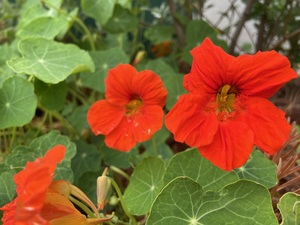
|
Nasturtium |
6-11
Full sun
Moist
Light (sandy), Medium
3.5
1
Annual, Perennial
Ground cover, Herbs
Fast
15cm
Seed - direct sow, Seed - transplant
1 week after last frost - late spring
2-4 weeks before last frost
2 weeks after last frost
7-12 days
12-18°C (55-65°F)
Pest control, oil, Fragrance
Flowers, Leaves, Seed, Seedpod
Oil, Condiment
Tropaeolum, Indian Cress
Große Kapuzinerkresse
Tropaeolaceae
Peru
Albania, Algeria, Amsterdam-St.Paul Is, Angola, Argentina Northeast, Ascension, Assam, Azores, Baleares, Bangladesh, Belgium, Bermuda, Bolivia, Brazil South, Brazil Southeast, Bulgaria, California, Cameroon, Canary Is., Cape Verde, Central European Rus, Chile Central, China South-Central, Colombia, Connecticut, Costa Rica, Cuba, Czechoslovakia, Dominican Republic, East Aegean Is., East Himalaya, Ecuador, El Salvador, Eritrea, Ethiopia, France, Free State, Great Britain, Greece, Guatemala, Haiti, Hawaii, Honduras, Jamaica, Juan Fernández Is., Korea, Kriti, Lebanon-Syria, Madeira, Massachusetts, Mauritius, Mexico Central, Mexico Northwest, Morocco, New Hampshire, New York, New Zealand North, New Zealand South, Norfolk Is., North European Russi, Oregon, Pennsylvania, Puerto Rico, Romania, Rwanda, Réunion, South European Russi, Spain, St.Helena, Tasmania, Tibet, Trinidad-Tobago, Tristan da Cunha, Tunisia, Uruguay, Vietnam, Zaïre
https://en.wikipedia.org/wiki/Tropaeolum_majus
https://pfaf.org/User/Plant.aspx?LatinName=Tropaeolum majus
https://powo.science.kew.org/taxon/urn:lsid:ipni.org:names:310974-2
true
|
Tropaeolum majus, commonly known as garden nasturtium, is a flowering plant that is native to South and Central America and can be grown annually as well as perennially. It belongs to the family Tropaeolaceae, which includes around 80 species of plants. T. majus is a popular garden plant, known for its bright, colorful flowers and attractive foliage. The flowers are typically yellow, orange, or red and have a distinctive, trumpet-like shape. The leaves are rounded and have a slightly waxy texture, and the plant produces long, trailing stems that can be used to create a cascading effect in hanging baskets or other containers. To grow T. majus, it is best to start the seeds directly in the ground or in pots after the last frost has passed. The plant prefers well-drained soil and full sun, but can also tolerate partial shade. It is important to water the plants regularly, but avoid overwatering, as this can cause the leaves to rot. T. majus can also be grown in containers and trained to climb trellises or other structures. In addition to its ornamental value, T. majus is also edible. The leaves, flowers, and seeds can be used in salads and other dishes, adding a slightly spicy, peppery flavor. The plant has also been used medicinally, as the leaves and seeds contain compounds with antibacterial and antioxidant properties. T. majus has been used to treat a variety of ailments, including respiratory infections and digestive disorders. It has also been used as a natural remedy for urinary tract infections and kidney stones. However, T. majus should be used with caution, as it can cause allergic reactions in some people. Additionally, T. majus can become invasive if allowed to spread, so gardeners should take care to keep it contained. #### Links [Nasturtium @ West Coast Seeds](https://www.westcoastseeds.com/products/jewel-mix ) |
Show
Edit |

|
Allium cepa |
3-9
Annual
Full sun
Moist
Light (sandy), Medium
0.6
Herbs
Flowers, Leaves, Root, Seed
Seed - direct sow, Seed - transplant
https://en.wikipedia.org/wiki/Onion
Garden onion
Alliaceae
Zwiebel
https://pfaf.org/User/Plant.aspx?LatinName=Allium cepa
50°f, 10°c
Seed indoors 6 weeks before transplanting in the garden
2-6 inches
6.0-7.0
Allium
Turkmenistan
Algeria, Argentina Northeast, Arkansas, Baltic States, Bangladesh, Belarus, Bulgaria, California, Cambodia, Canary Is., Central European Rus, China North-Central, China South-Central, China Southeast, Colombia, Cuba, Czechoslovakia, Dominican Republic, East Aegean Is., East European Russia, East Himalaya, Ecuador, Egypt, Ethiopia, Fiji, France, Galápagos, Guinea-Bissau, Haiti, Illinois, India, Iraq, Italy, Jamaica, Kansas, Kentucky, Kirgizstan, Korea, Krym, Libya, Louisiana, Madeira, Manchuria, Mauritania, Mexico Central, Mexico Gulf, Mexico Northeast, Mexico Southeast, Mexico Southwest, Minnesota, Montana, Morocco, New York, Niue, North European Russi, Northwest European R, Oregon, Pakistan, Puerto Rico, Seychelles, South European Russi, Spain, Tadzhikistan, Texas, Thailand, Tibet, Tonga, Trinidad-Tobago, Ukraine, Uzbekistan, Vermont, Washington, West Himalaya, West Siberia, Wisconsin, Xinjiang, Yugoslavia
Spring or fall
0.3
https://powo.science.kew.org/taxon/urn:lsid:ipni.org:names:527795-1
Cosmetic, Dye, Hair, Polish, Rust
true
|
Onion (Allium cepa) is a plant species in the family Amaryllidaceae. It is native to central Asia and is commonly grown as a vegetable in many parts of the world. Onions are biennial plants, meaning they typically have a two-year life cycle. In the first year, the onion forms a small, rounded bulb with thin, papery skin. In the second year, the onion will produce a tall stem with hollow, elongated leaves and a small, spherical flower head. Onions are typically grown for their bulbs, which are used as a food ingredient in many dishes. The bulbs can vary in size and shape, depending on the variety, but are generally spherical or oblong in shape and range in size from about 2-4 inches in diameter. Onions are commonly differentiated by their color, which can range from white to yellow to red. Onions prefer well-drained soil that is rich in organic matter. They should be planted in a sunny location and will benefit from regular watering, especially during dry periods. Onion bulbs can be harvested when they reach the desired size, typically after about 100-150 days of growth. To store onions, they should be dried and cured in a cool, dry place for about two weeks before being placed in a mesh bag or other breathable container. Onions are edible and are commonly used as a food ingredient in many dishes. The bulbs are the most commonly used part of the plant, but the leaves and stems can also be used in cooking. Onions have a pungent, spicy flavor and are often used to add flavor to soups, stews, and other dishes. Onions can be stored for several months if properly dried and cured. In addition to their use as a food ingredient, onions have also been used for their medicinal properties. They have been used to treat a variety of ailments, including coughs, colds, and respiratory infections. Onions are also sometimes used as a natural fertilizer, due to the high levels of sulfur and other nutrients they contain. Onions are not known to provide significant value to wildlife. They are not a preferred food source for most animals and do not provide any significant habitat value. However, some insects, such as the onion maggot, can be pests of onion crops. |
Show
Edit |

|
Parsley |
5-8
Biennial
Full sun, Partial sun/shade
Moist
Light (sandy), Medium, Heavy (clay)
0.6
Herbs
true
Leaves
https://en.wikipedia.org/wiki/Parsley
Medium
Apiaceae or umbelliferae
Petersilie
https://pfaf.org/User/Plant.aspx?LatinName=Petroselinum crispum
Algeria
Greece, Morocco, Yugoslavia
15cm
https://powo.science.kew.org/taxon/urn:lsid:ipni.org:names:60442790-2
Colouring, Tea
Essential Oil, Hair, Dynamic accumulator, Fragrance
|
Parsley is a herb native to the central and eastern Mediterranean region. It has bi-pinnate leaves and small, white or green flowers. The plant grows to a height of about 30 cm and has a fast growth rate. It can be differentiated from similar plants by its bi-pinnate leaves and small, white or green flowers. Parsley prefers well-drained soil and full sun to partial shade. To cultivate it successfully, a grower may need to water it regularly and protect it from frost. The plant is winter hardy and can withstand cold temperatures. Parsley is edible and its leaves and stems can be used in cooking. The edible parts can be stored after harvest by drying or freezing. Parsley has many uses, including medicinal and culinary. It has been used to treat a variety of ailments, such as indigestion and inflammation. In the kitchen, it can be used as a garnish or added to dishes for flavor. Parsley is also a good source of vitamins and minerals, such as vitamins A and C and iron. Parsley is valuable for wildlife as it provides nectar for pollinators. It is also a good source of food for some animals, such as rabbits and deer. #### Links [Parsley @ Wikipedia](https://en.wikipedia.org/wiki/Parsley) |
Show
Edit |
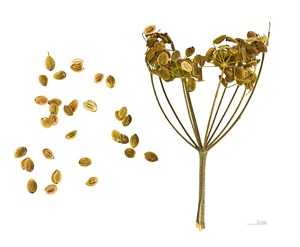
|
Pastinaca sativa |
https://en.wikipedia.org/wiki/Parsnip
true
Moist
Full sun, Partial sun/shade
4-8
Wild parsnip
Light (sandy), Medium, Heavy (clay)
Apiaceae or umbelliferae
1.0
Pastinake
Roots
Leaves, Root, Seed, Shoots
Weed potential
Biennial
https://pfaf.org/User/Plant.aspx?LatinName=Pastinaca sativa
Sicilia
Albania, Altay, Austria, Baltic States, Belarus, Belgium, Bulgaria, Central European Rus, Corse, Czechoslovakia, East European Russia, France, Germany, Great Britain, Greece, Hungary, Italy, Krasnoyarsk, Krym, Lebanon-Syria, Mongolia, Netherlands, North Caucasus, Poland, Romania, Sardegna, South European Russi, Spain, Switzerland, Transcaucasus, Turkey, Turkey-in-Europe, Ukraine, West Siberia, Yugoslavia
https://powo.science.kew.org/taxon/urn:lsid:ipni.org:names:845768-1
0.4
Condiment
Pest control
|
Show
Edit |
|

|
Broccoli |
2-11
Full sun, Partial sun/shade
Moist
Light (sandy), Medium, Heavy (clay)
6.0-7.0
0.9
Annual, Biennial
45cm
6-8 weeks before last frost
7-10 days
4°C (40°F)
50-100
3 to 7 years
Companion
true
Flowers, Leaves, Shoots
Brokkoli
Brassicaceae or Cruciferae
https://pfaf.org/User/Plant.aspx?LatinName=Brassica oleracea italica
|
Broccoli is a plant that is native to the Mediterranean region. It is part of the Brassica oleracea family, which also includes other vegetables such as cauliflower and cabbage. Broccoli plants have green, flowering heads that are similar in appearance to cauliflower. The stems are typically thick and can grow to be quite large, depending on the variety of broccoli. The leaves of the plant are typically dark green and are arranged in a spiral pattern along the stem. When it comes to growing conditions, broccoli prefers cool weather and well-draining soil. It is a relatively fast-growing plant, with the flowering heads typically forming in the first year. To cultivate broccoli successfully, a grower will need to make sure the plant gets enough water and sunlight, and provide it with the necessary nutrients through fertilization. In terms of winter hardiness, broccoli is not very frost-tolerant, so it is typically grown as a cool-season crop in areas with mild winters. In terms of edibility, broccoli is a very nutritious vegetable that is packed with vitamins and minerals. The flowering heads and the stems are both edible, and can be cooked in a variety of ways. After harvest, broccoli can be stored in the refrigerator for several days, or frozen for longer-term storage. ### Propagation - Direct sow Sow seeds 7cm apart, thin when seedlings reach 5-7cm in height. ### Propagation - Transplant Start seeds 6-8 weeks before your last frost date, or 2-3 weeks before last frost date. Plant outside when seedlings are 4-6 weeks old, or have 4-5 leaves. #### Links [Broccoli @ Almanac](https://www.almanac.com/plant/broccoli) |
Show
Edit |

|
Rose |
2
Perennial
Full sun, Partial sun/shade
Deciduous
Shrubs
Animal feed, Attracts insects, Hedgerow, Wind breaker, Wildlife habitat
True
Fruit
Rosaceae
Zambia
https://powo.science.kew.org/taxon/urn:lsid:ipni.org:names:77120313-1
1
|
Show
Edit |
|

|
Capsicum Annuum Grossum |
true
Medium
Moist
Full sun
10-11
Cayenne pepper, chili pepper, christmas pepper, red pepper, ornamental chili pepper
Light (sandy), Medium, Heavy (clay)
Solanaceae
1.0
Paprika, gemüsepaprika
Flowers, Fruit, Leaves
Perennial
https://pfaf.org/User/Plant.aspx?LatinName=Capsicum annuum
Colouring, Condiment
Companion
|
Show
Edit |
|

|
Jalapeño Chili |
0.6
Annual
Jalapeño
Solanaceae
|
Can be eaten green. |
Show
Edit |
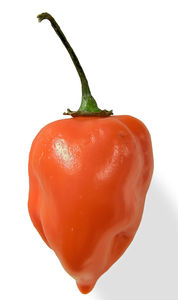
|
Habanero |
Solanaceae
|
The habanero is a hot variety of chili pepper. Unripe habaneros are green, and they color as they mature. The most common color variants are orange and red, but the fruit may also be white, brown, yellow, green, or purple. Typically, a ripe habanero is 2–6 cm (0.8–2.4 in) long. Habanero chilis are very hot, rated 100,000–350,000 on the Scoville scale. The habanero's heat, flavor and floral aroma make it a popular ingredient in hot sauces and other spicy foods. |
Show
Edit |
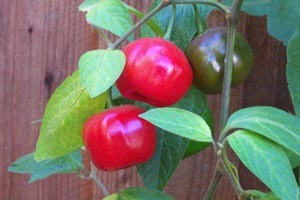
|
Capsicum pubescens |
https://en.wikipedia.org/wiki/Capsicum_pubescens
true
Moist
Full sun
8-11
Rocoto
Light (sandy), Medium, Heavy (clay)
Solanaceae
3.0
Rocoto chili, baumchili
Fruit
Perennial
https://pfaf.org/User/Plant.aspx?LatinName=Capsicum pubescens
Bolivia, Ecuador, Peru
Colombia, Costa Rica, Guatemala, Honduras, Mexico Southwest, Venezuela
https://powo.science.kew.org/taxon/urn:lsid:ipni.org:names:814839-1
Condiment
|
Show
Edit |
|

|
Garlic |
3-10
Perennial
Full sun
Dry, Moist
Light (sandy), Medium
0.6
Herbs
Flowers, Leaves, Root, Seed
Seed - direct sow
https://en.wikipedia.org/wiki/Garlic
Cultivated garlic
Alliaceae
Knoblauch
20cm
https://pfaf.org/User/Plant.aspx?LatinName=Allium sativum
6.5-7.0
Sting and itch relief from insect bites
Fibrous
Shallow
100-150
Allium
Iran, Kazakhstan, Kirgizstan, Tadzhikistan, Turkmenistan, Uzbekistan
Albania, Algeria, Amur, Austria, Baleares, Baltic States, Bangladesh, Belarus, Bulgaria, Cambodia, Canary Is., Central European Rus, China North-Central, China South-Central, China Southeast, Corse, Cuba, Czechoslovakia, Dominican Republic, East European Russia, Egypt, Ethiopia, France, Galápagos, Germany, Greece, Haiti, Hungary, Illinois, India, Iraq, Italy, Jamaica, Kentucky, Korea, Leeward Is., Libya, Mexico Central, Mexico Northwest, Mexico Southeast, Mexico Southwest, Morocco, New York, North European Russi, Northwest European R, Pakistan, Poland, Primorye, Puerto Rico, Romania, Sardegna, Seychelles, Sicilia, South European Russi, Spain, Switzerland, Tennessee, Thailand, Trinidad-Tobago, Tunisia, Turkey, Ukraine, Vermont, Wisconsin, Yugoslavia
Late autumn, Early spring
https://powo.science.kew.org/taxon/urn:lsid:ipni.org:names:528796-1
Adhesive, antifungal, Dynamic accumulator
true
|
Garlic (Allium sativum) is a bulbous perennial plant in the family Amaryllidaceae. It is native to central Asia and northeastern Iran, and has long been a staple in cuisines around the world. The plant has a distinctive appearance, with narrow, long leaves and a tall, hollow stem. The leaves are a pale green color and are attached to the stem in a spiral arrangement. The flowers are small and white, and are clustered in a spherical head at the top of the stem. Garlic plants can grow to a height of 30-150 cm (12-59 in), depending on the variety. They are relatively fast-growing plants, with the bulbs maturing in about seven months. Mulch for proper overwintering when planted in autumn. Garlic can be differentiated from other plants in the Allium genus by its distinctive flavor and aroma. It is also often distinguished by its long, narrow leaves and tall, hollow stem. Garlic prefers well-drained soil and full sun, and is typically grown from bulbs. To cultivate garlic successfully, growers should plant the bulbs in the fall, about 6-8 weeks before the first frost. The bulbs should be spaced about 10-15 cm (4-6 in) apart, with the pointed end facing up. After planting, the bulbs should be watered regularly and mulched to protect them from cold temperatures. Garlic is edible, with the bulbs and leaves being the most commonly eaten parts of the plant. The bulbs can be used fresh or cooked, and are often used as a seasoning in a wide variety of dishes. The leaves can be used fresh or cooked, and have a milder flavor than the bulbs. To harvest dig and do not pull out the bulbs. Let them dry in an airy, shady and dry spot e.g. by hanging them up. Once wrappers are dry, it can be stored at a dry place for several months. In addition to its culinary uses, garlic has a number of other uses. It is commonly used medicinally, as it has been shown to have antimicrobial and anti-inflammatory properties. It is also sometimes used as a natural insect repellent. In the garden, it can be used as a natural fertilizer, as it is believed to improve the soil and help deter pests. Garlic has value for wildlife, as it is attractive to a wide variety of pollinators, including bees, butterflies, and hummingbirds. It is also a food source for animals such as rabbits and deer. |
Show
Edit |

|
Kale |
5-10
Full sun, Partial sun/shade
Moist
Light (sandy), Medium, Heavy (clay)
6.0-6.8
Deciduous
0.9
Biennial, Perennial
Herbs
Fast
45cm
Seed - direct sow, Seed - transplant
At last frost date
4-6 weeks before last frost
7-10 days
3 to 7 years
Dynamic accumulator
true
Shoots
Brassicaceae, Cruciferae
True
https://en.wikipedia.org/wiki/Kale
https://pfaf.org/User/Plant.aspx?LatinName=Brassica oleracea acephala
Shallow
0.5 cm
60
|
Kale (/keɪl/) is a hardy, leafy green vegetable that is a member of the Brassica oleracea species. It is native to the eastern Mediterranean and Asia Minor, and has been cultivated for food for over 2000 years. Kale plants typically have green or purple leaves that are deeply lobed and can grow up to 2 feet in length. The leaves are attached to a central stem and don't make a head, and the plant produces small, yellow flowers. Kales are considered to be closer to wild cabbage than most of the many domesticated forms of Brassica oleracea. In terms of growing conditions, kale prefers cool weather and does well in full sun to partial shade. It can be grown year-round in mild climates, but in colder climates it is best grown in the fall and early spring. To cultivate kale successfully, it is important to provide the plants with plenty of moisture and to regularly fertilize them. Kale is also a good companion plant for other vegetables, as it can help to deter pests and improve the health of the soil. In terms of edibility, kale is highly nutritious and can be eaten raw or cooked. The leaves and stems are both edible, and the plant can be stored in the refrigerator for several days after harvest. Kale can be used in a variety of dishes, including soups, salads, and smoothies. It can also be cooked and served as a side dish, or used as a garnish. In addition to its culinary uses, kale has a number of other uses. It is often used as a cover crop, as it can help to improve the fertility of the soil. Kale leaves can also be used as a mulch, as they break down readily and release nutrients into the soil. Additionally, kale plants can be used for wind protection, as their large leaves and sturdy stems can provide a barrier to wind. ### Links [Kale @ West Coast Seeds](https://www.westcoastseeds.com/blogs/how-to-grow/grow-kale-collards) |
Show
Edit |
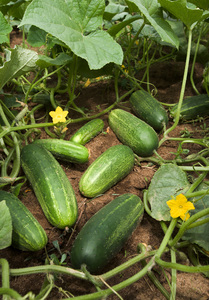
|
Cucumis sativus |
9-11
Annual
Full sun
Moist
Light (sandy), Medium, Heavy (clay)
2
Vines
Fruit, Leaves, Seed
Seed - direct sow, Seed - transplant
1 week after last frost
https://en.wikipedia.org/wiki/Cucumber
Cucurbitaceae
Gurke
50-65
23cm
6.0-6.8
15-30°C (60-85°F)
https://pfaf.org/User/Plant.aspx?LatinName=Cucumis sativus
True
Fruit
Assam, Bangladesh, China South-Central, China Southeast, East Himalaya, Myanmar, Nepal, Thailand, West Himalaya
Alabama, Albania, Andaman Is., Arizona, Arkansas, Austria, Bahamas, Bolivia, Caroline Is., Cayman Is., Colombia, Costa Rica, Cuba, Czechoslovakia, Denmark, Dominican Republic, Ecuador, Florida, Georgia, Gulf of Guinea Is., Haiti, Illinois, India, Jamaica, Kansas, Kazakhstan, Kentucky, Korea, Laos, Leeward Is., Louisiana, Marianas, Marshall Is., Massachusetts, Michigan, Mississippi, Missouri, New Caledonia, New York, Nicaragua, Nicobar Is., North Carolina, North Caucasus, Ohio, Oman, Ontario, Pakistan, Pennsylvania, Pitcairn Is., Puerto Rico, South Carolina, Sri Lanka, Sweden, Tadzhikistan, Trinidad-Tobago, Turkmenistan, Utah, Uzbekistan, Venezuela, Vietnam, Virginia, Windward Is., Zaïre
2-3 weeks before last frost
1 week after last frost
0.9
https://powo.science.kew.org/taxon/urn:lsid:ipni.org:names:292296-1
Oil
Cosmetic, oil
true
|
Cucumber, scientific name Cucumis sativus, is a member of the gourd family. It is native to India and other parts of Asia. Cucumber is a trailing or climbing plant that grows to a height of 5-10 feet. The leaves are dark green and glossy, and the plant produces yellow flowers. The fruit of the cucumber plant is a long, green, edible vegetable with a thin skin. Cucumbers are typically about 6-9 inches long and 2-3 inches in diameter. In terms of growth and cultivation, cucumber plants prefer warm, sunny conditions and well-draining soil. They should be watered regularly, especially during dry periods. Cucumber plants are not winter hardy and should be grown in the summer months in most climates. To cultivate cucumbers successfully, it is important to provide them with adequate space to grow and to support the plants with trellises or other means to keep the fruits off the ground. The plant will develop male and female flowers. You can recognize the female by having a tiny cucumber underneath. Sometimes the plant develops a lot of male flowers first, so be patient. If you don’t see any bees pollinating. Take a male and put it on all the female flowers. Cucumber fruits are edible and can be eaten raw, pickled, or cooked. The skin and seeds of the cucumber are edible, but some people choose to remove the seeds before eating the fruit. Cucumber fruits can be stored in the refrigerator for a few days after harvest. Cucumbers have several uses. In addition to being eaten as a vegetable, they can also be used in a variety of dishes and salads. Cucumber slices are often used as a garnish or as a refreshing addition to beverages. Cucumbers are also commonly used in natural skin care products and are believed to have anti-inflammatory and soothing properties. #### Propagation Direct sow when soil is warm enough in early summer. Sow seeds individually indoors 3-4 weeks before planting outside into warm soil. Use bottom heat if possible. Transplant when plants develop third leaf. #### Medicinal Fruit is depurative, diuretic, emollient, purgative and resolvent #### Links [Cucumber @ West Coast Seeds](https://www.westcoastseeds.com/products/patio-snacker) |
Show
Edit |
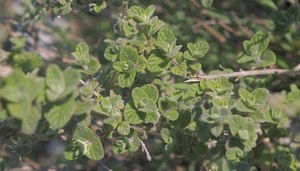
|
Origanum vulgare |
4-10
Full sun, Partial sun/shade
Dry, Moist
Light (sandy), Medium, Heavy (clay)
4.5–8.7
0.6
0.6
Perennial
Herbs
Medium
20cm
true
Flowers, Leaves, Stem
Condiment, Tea
Pot Marjoram
Lamiaceae or Labiatae
Afghanistan, Albania, Algeria, Altay, Austria, Azores, Baleares, Baltic States, Belarus, Belgium, Bulgaria, Buryatiya, Canary Is., Central European Rus, China North-Central, China South-Central, China Southeast, Corse, Cyprus, Czechoslovakia, Denmark, East Aegean Is., East European Russia, East Himalaya, Finland, France, Germany, Great Britain, Greece, Hungary, India, Iran, Iraq, Ireland, Irkutsk, Italy, Kazakhstan, Kirgizstan, Krasnoyarsk, Kriti, Krym, Madeira, Morocco, Nepal, Netherlands, North Caucasus, North European Russi, Northwest European R, Norway, Pakistan, Poland, Portugal, Romania, Sardegna, Sicilia, South European Russi, Spain, Svalbard, Sweden, Switzerland, Tadzhikistan, Taiwan, Tibet, Transcaucasus, Tunisia, Turkey, Turkey-in-Europe, Turkmenistan, Tuva, Ukraine, Uzbekistan, West Himalaya, West Siberia, Xinjiang, Yakutskiya, Yugoslavia
Arkansas, British Columbia, California, Connecticut, Delaware, Illinois, Maryland, Massachusetts, Mexico Southwest, Michigan, New Jersey, New York, New Zealand South, North Carolina, Nova Scotia, Ohio, Ontario, Oregon, Pennsylvania, Primorye, Prince Edward I., Québec, Venezuela, Vermont, Virginia, Washington
https://en.wikipedia.org/wiki/Oregano
https://pfaf.org/User/Plant.aspx?LatinName=Origanum vulgare
https://powo.science.kew.org/taxon/urn:lsid:ipni.org:names:453395-1
best in late Spring; softwood cuttings root fastest
true
Dye, Essential Oil, Pest control, Strewing, Dynamic accumulator, Ground cover, Fragrance
|
Oregano, also known as Origanum vulgare, is a herb that is native to the Mediterranean region. It is a small, bushy plant that grows to a height of about 1 to 2 feet and has a woody stem. The leaves are oval-shaped and are covered in small hairs. The flowers are small and white or purple in color and grow in clusters. Oregano grows best in well-drained, fertile soil in a sunny location. It is winter hardy and can withstand cold temperatures. To cultivate oregano successfully, a grower may need to provide adequate watering and sunlight, and may also need to prune the plant regularly to keep it from becoming leggy. The leaves of the oregano plant are edible and can be used fresh or dried in cooking. They have a strong, pungent flavor and are commonly used in Italian, Greek, and Mexican cuisine. The leaves can be stored after harvest by drying them and storing them in an airtight container. In addition to its use in cooking, oregano has also been used in traditional medicine to treat a variety of conditions, including respiratory problems and digestive issues. It is also known to attract pollinators, making it valuable for wildlife. |
Show
Edit |

|
Cauliflower |
3-10
Full sun, Partial sun/shade
Moist
Light (sandy), Medium, Heavy (clay)
0.8
Annual, Biennial
3-7 years
Companion, antifungal, Dynamic accumulator
true
Flowers, Leaves
Blumenkohl
Brassicaceae or cruciferae
https://pfaf.org/User/Plant.aspx?LatinName=Brassica oleracea botrytis
|
Annual plant reproduced by seed. |
Show
Edit |
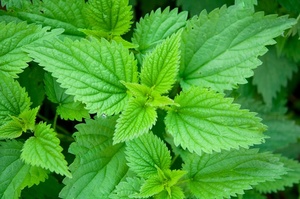
|
Urtica dioica |
3-10
Perennial
Full sun, Partial sun/shade
Moist
Light (sandy), Medium, Heavy (clay)
1.2
Herbs
true
Leaves, Shoots
https://en.wikipedia.org/wiki/Urtica_dioica
Fast
California nettle, achoka, bichhu booti, bichhua, bichua, chichru, irhawurhawu, kopriva, korvenoges, krapiva, noges, patle sishnu, pokrzywa, polo, raudnoges, sishnu, sisnu, tall nettle, zara, zastisod, zocha, american stinging nettle, brandnetelwortel, brennessel, brennesselblätter, brennesselwurzel, brennnesselwurzel, brännässelrot, brännässla, brännässleblad, brændenælderod, california nettle, chalkan, chayan oot, chhoku, chichicaste, chule, chutle, common nettle, common stinging nettle for homoeopathic preparations, csalángyökér, csalánlevé, dhyo, european nettle, european stinging nettle, folia urticae, gazanda, gazaneh, gazgazuk, giant nettle, grande ortie, great nettle, greater nettle, grosse brennessel, große brennessel, gherq il-hurrieq, haarnesselwurzel, hanfnesselwurzel, hhurrayq, horeig, hyo, jhaduk, kajyang, kichitki oot, kopriva, koprivový koren, korenina koprive, korzen pokrzywy, krapiva dvudomnaya, nelau, neslerot, nesselwurzel, nettle, nettle herb, nettle leaf, nettle root, nettle stinging, nhyakan, nokkonen, juuri, nõgesejuur, natru saknes, ortica, ortica maschio, ortica radice, ortie, ortie (feuille d’), ortie (racine d'), ortie brulante, ortie dioïque, ortiga, ortiga mayor, hoja, raíz de, pokrzywa, polo, pulu, prhlavový koren, qurrays, racine d'ortie, radix urticae, raiz de ortiga, radacina de urzica, satu, sikya, sisna, sisnu, slender nettle, stinging nettle, stinging nettle herb, syak, tall nettle, tsuknida, urtica dioica, urtica dioica ad praeparationes homoeopathicas, urticae folium, urticae herba, urticae radix, urtiga, raiz, urtiga-maior, urtiga-mansa, urtiga-vermelha, urtigão, yi zhu qian ma, za-chhag, zwa, zwyczajna, isirgan
Urticaceae
Brennnessel
Oil, Colouring, Curdling agent, Drink
Weed potential
https://pfaf.org/User/Plant.aspx?LatinName=Urtica dioica
Afghanistan, Albania, Algeria, Altay, Amur, Assam, Austria, Baltic States, Belarus, Belgium, Bulgaria, Buryatiya, Central European Rus, China North-Central, China South-Central, Chita, Corse, Czechoslovakia, Denmark, East Aegean Is., East European Russia, East Himalaya, Finland, France, Føroyar, Germany, Great Britain, Greece, Hungary, Iceland, India, Inner Mongolia, Iran, Iraq, Ireland, Irkutsk, Italy, Japan, Kamchatka, Kazakhstan, Khabarovsk, Kirgizstan, Korea, Krasnoyarsk, Kriti, Krym, Lebanon-Syria, Magadan, Manchuria, Mongolia, Morocco, Nepal, Netherlands, North Caucasus, North European Russi, Northwest European R, Norway, Pakistan, Poland, Portugal, Primorye, Qinghai, Romania, Sakhalin, Sardegna, Sicilia, South European Russi, Spain, Sweden, Switzerland, Tadzhikistan, Tibet, Transcaucasus, Tunisia, Turkey, Turkey-in-Europe, Turkmenistan, Tuva, Ukraine, Uzbekistan, West Himalaya, West Siberia, Xinjiang, Yakutskiya, Yugoslavia
Alabama, Alaska, Argentina Northeast, Bolivia, Brazil Northeast, Brazil South, Brazil Southeast, British Columbia, California, Cape Provinces, Chile Central, Chile South, Colombia, Connecticut, Delaware, District of Columbia, Ecuador, Eritrea, Falkland Is., Florida, Georgia, Greenland, Guatemala, Libya, Maine, Maryland, Massachusetts, Michigan, Missouri, New Brunswick, New Hampshire, New Jersey, New York, New Zealand North, New Zealand South, Newfoundland, North Carolina, Nova Scotia, Ohio, Oklahoma, Ontario, Oregon, Pennsylvania, Prince Edward I., Québec, Svalbard, Tennessee, Tristan da Cunha, Virginia, Washington, West Virginia
https://powo.science.kew.org/taxon/urn:lsid:ipni.org:names:260630-2
Biomass, Compost, Dye, Fiber, Hair, Animal feed, oil, Waterproofing, Dynamic accumulator
|
Stinging nettle (Urtica dioica) is a perennial plant that is native to many parts of Europe, Asia, and North America. It is found in a variety of habitats, including damp forests, stream banks, and meadows. Stinging nettle has green, heart-shaped leaves that are arranged opposite each other on the stem. The leaves and stems are covered with tiny, hollow hairs that can inject a painful, stinging sensation when they come into contact with skin. The plant also produces small, greenish-white flowers that grow in clusters. Stinging nettle can grow to be quite tall, sometimes reaching heights of up to six feet. It grows quickly and can spread rapidly. To cultivate stinging nettle, it is best to start with rooted cuttings or small plants. The plant prefers moist, well-draining soil and partial shade, but it can also grow in full sun. It is important to keep the soil consistently moist, especially during the plant's first growing season. Stinging nettle is edible, but the leaves and stems must be cooked or dried to remove the stinging hairs. The leaves can be used in a variety of dishes, including soups, stews, and teas. They can also be dried and stored for later use. The roots can also be eaten, but they are more difficult to harvest and prepare. Stinging nettle has a number of uses, both medicinal and practical. The leaves and stems can be used to make a tea that is rich in vitamins and minerals, and has been used to treat a variety of conditions, including arthritis, eczema, and gout. The plant can also be used as a natural fertilizer, thanks to its high nitrogen content. In addition, the leaves can be used as mulch, and the fibers from the stems can be used to make ropes and cloth. Stinging nettle is also valuable for wildlife, providing food and habitat for a variety of animals. The leaves are a source of food for many species of butterflies and moths, and the plant also provides shelter for small mammals and birds. Overall, stinging nettle is a versatile and useful plant that has a variety of applications for gardeners, farmers, and herbalists. Despite its painful sting, it is a valuable addition to any garden or landscape. |
Show
Edit |
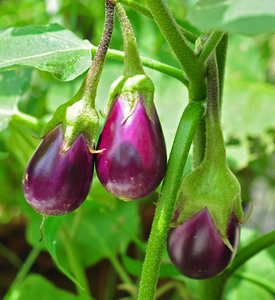
|
Solanum melongena |
8-11
Full sun
Moist
Light (sandy), Medium, Heavy (clay)
1.0
1
Perennial
true
Fruit, Leaves
Eggplant
Aubergine
Solanaceae
China South-Central, Laos, Malaya, Myanmar, Thailand, Vietnam
Assam, Bangladesh, Cambodia, East Himalaya, India, Kazakhstan, Laccadive Is., Sri Lanka, Tadzhikistan, Turkmenistan, Uzbekistan, Zaïre
https://en.wikipedia.org/wiki/Eggplant
https://pfaf.org/User/Plant.aspx?LatinName=Solanum melongena
https://powo.science.kew.org/taxon/urn:lsid:ipni.org:names:820053-1
|
The eggplant, also known as Solanum melongena, is a plant that is native to India and Southeast Asia. It is typically an annual plant. It is a member of the nightshade family and is closely related to other vegetables such as tomatoes and peppers. Eggplants are typically recognized by their deep purple, spongy fruit, but they can come in a variety of sizes and colors (white, green, black, purple striped). The fruit is elongated and cylindrical in shape, and can grow to be anywhere from 6-12 inches in length. The leaves of the eggplant are broad and dark green in color, and the plant itself can grow to be quite tall, reaching heights of 3-4 feet. Eggplants prefer warm, sunny growing conditions and can be grown in a wide range of soils as long as they are well-draining. They are typically grown as a summer crop, and will begin to produce fruit around 2-3 months after planting. To cultivate eggplants successfully, a grower will need to provide the plants with adequate water and nutrients, and may need to use stakes or other supports to help the plant grow upright. Eggplants are not winter hardy and will not survive freezing temperatures. The fruit of the eggplant is edible and is often used in a variety of dishes, particularly in Mediterranean and Asian cuisines. It can be sliced and fried, grilled, or used in stews and soups. The skin of the fruit is typically removed before eating, and the flesh can be stored in the refrigerator for a few days after harvesting. In addition to being used as a food source, eggplants have also been used for medicinal purposes in some cultures. The plant is believed to have anti-inflammatory properties, and has been used to treat a variety of ailments including headache and rheumatism. It is also sometimes used as a natural insect repellent. |
Show
Edit |
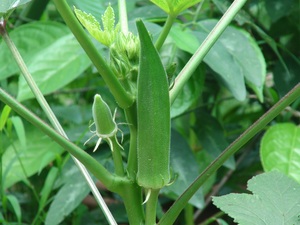
|
Abelmoschus esculentus |
5-11
Full sun
Moist
Light (sandy), Medium, Heavy (clay)
1.0
1.7
Annual, Perennial
Herbs
true
Fruit, Leaves, Root, Seed
Oil, Coffee, Pectin
A-koto, angu, apala, asowntem, bakhua-mun, bamia, bandakka, bendi, bhindee, bhindi, binda, bindi, bondo, cantarela, derere rechipudzi, derere, dheras, dherosh, enmomi, fetri, gombaut, gombo, gumbo, guro, gusha, hakuyot, idelele, ikhievbo, ilasha, ilo, ka fei huang kui, kacang bendi, kaganh lender, kandia, kandjie, kopi arab, krachiap-mon, kubewa, lafeu, lieka, loka, maana, ma-lontho, mesta, muomi, miagorro, nathando, nkruma, obori, ochro, okworu, okwulu, otigo-iwoka, pahari bendi, pingpesi, poot barang, pui, quiabo, quimbambo, saluyot a bunga, sayur bendi, taku, uisul hme, vandakai, vandikkai, vendal, wayika, you-padi
Malvaceae
Bangladesh, India, Myanmar
Alabama, Albania, Andaman Is., Angola, Assam, Bahamas, Benin, Borneo, Bulgaria, Burkina, Cambodia, Cape Verde, Caroline Is., Cayman Is., Central African Repu, Chad, China South-Central, China Southeast, Comoros, Congo, Cuba, Dominican Republic, East Himalaya, Eritrea, Fiji, Florida, Gabon, Gambia, Georgia, Greece, Guinea-Bissau, Gulf of Guinea Is., Hainan, Haiti, Illinois, Ivory Coast, Jamaica, Jawa, Krym, KwaZulu-Natal, Laos, Leeward Is., Louisiana, Malaya, Mali, Marianas, Marshall Is., Maryland, Mauritania, Mexico Southwest, Mississippi, Mozambique, Nicobar Is., Niger, Nigeria, North Carolina, Northern Provinces, Oman, Pakistan, Peru, Philippines, Puerto Rico, Romania, Senegal, Sierra Leone, South Carolina, South European Russi, Southwest Caribbean, Sri Lanka, Sudan, Tanzania, Thailand, Togo, Uganda, Ukraine, Venezuela, Venezuelan Antilles, Vietnam, Virginia, Windward Is., Zambia, Zaïre, Zimbabwe
https://en.wikipedia.org/wiki/Okra
https://pfaf.org/User/Plant.aspx?LatinName=Abelmoschus esculentus
https://powo.science.kew.org/taxon/urn:lsid:ipni.org:names:558006-1
Weed potential
Fiber, oil, textiles, Pectin
|
Show
Edit |
|
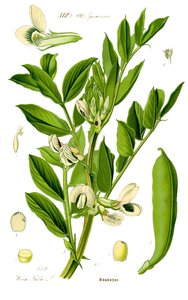
|
Broad Bean |
4-8
Full sun, Partial sun/shade
Moist
Light (sandy), Medium, Heavy (clay)
6.0-6.8
1.0
0.3
Annual
Fast
20cm
Seed - direct sow, Seed - transplant
6 weeks after sowing them in pots
6 weeks after sowing them in pots
21 days
3-5 years
Nitrogen fixer
Leaves, Seed
fava bean, faba bean, Broad bean, or faba bean Varieties with smaller, harder seeds that are fed to horses or other animals are called field bean, tic bean or tick bean Horse bean
Ackerbohne
Fabaceae or Leguminosae
Afghanistan, Iran
Albania, Algeria, Altay, Angola, Argentina South, Assam, Baleares, Bangladesh, Bolivia, Bulgaria, Cameroon, Canary Is., Central European Rus, Chad, China North-Central, China South-Central, China Southeast, Colombia, Corse, Cuba, Cyprus, Czechoslovakia, Dominican Republic, East Aegean Is., East European Russia, Ecuador, Ethiopia, France, Guatemala, India, Iraq, Italy, Jawa, Kenya, Krym, Lebanon-Syria, Leeward Is., Libya, Madeira, Mexico Southwest, Mongolia, Morocco, Myanmar, Nepal, New South Wales, New York, New Zealand North, New Zealand South, Pakistan, Peru, Portugal, Puerto Rico, Rwanda, Sardegna, Sicilia, Spain, Sri Lanka, Sudan, Tibet, Tunisia, Turkey, Turkey-in-Europe, Uruguay, Vermont, Vietnam, West Himalaya, Yemen, Yugoslavia
https://en.wikipedia.org/wiki/Vicia_faba
https://pfaf.org/User/Plant.aspx?LatinName=Vicia faba major
https://powo.science.kew.org/taxon/urn:lsid:ipni.org:names:524737-1
Feb-April; Oct-Nov
sow in deep pots in cool, frost-free place
|
Broad bean (Vicia faba), also known as fava bean or faba bean, is a type of legume that is native to North Africa and the Middle East. It is a popular garden plant, known for its edible beans and attractive purple or white flowers. Broad bean plants have a upright, bushy growth habit and can reach a height of up to 3 feet. The leaves are large and composed of three oval-shaped leaflets, and the flowers are small and clustered in groups of two or three. The beans are produced in long, slender pods that contain two or three beans each. To grow broad beans successfully, it is important to choose a location with well-drained, fertile soil and full sun. The plants should be spaced about 8-12 inches apart, and watered regularly to ensure that the soil stays moist but not waterlogged. Broad beans are generally easy to grow and require little maintenance, but they can be susceptible to pests and diseases, such as aphids and fungal infections. Grows best in temperatures ranging from 60° to 65°F (15-18°C) but will tolerate a range from 40°F (4.4°C) - 75°F (24°C). Broad beans are edible, and the beans can be eaten fresh or frozen, canned or dried for storage. To harvest the beans, the pods should be picked when they are plump and before the beans inside begin to harden. The beans can be removed from the pods by gently squeezing them out. Fresh beans can be stored in the refrigerator for a few days, while dried beans can be stored in an airtight container for several months. In addition to their culinary uses, broad beans also have a number of medicinal properties, and have been used to treat a variety of ailments, including asthma, bronchitis, and anemia. Broad beans are also a valuable food source for many types of wildlife, including birds, insects, and small mammals. The plants provide nectar for bees and other pollinators, and the beans are a popular food for many species of birds. |
Show
Edit |
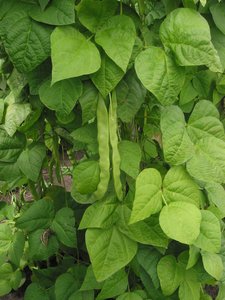
|
Common bean |
2-11
Annual
Full sun
Moist
Light (sandy), Medium, Heavy (clay)
2.0
Vines
Biomass, Dye, antifungal, Nitrogen fixer
true
Leaves, Seed, Seedpod
Seed - transplant, Seed - direct sow
https://en.wikipedia.org/wiki/Phaseolus_vulgaris
Pole bean, Climbing bean, French bean, Bush bean, Dwarf bean, Kidney bean, Green bean
Fabaceae, Leguminosae
Stangenbohne
https://pfaf.org/User/Plant.aspx?LatinName=Phaseolus vulgaris
16-18°c (70-80°f)
6.0-6.8
2.5 cm
16cm
4-10 days
45-85
Fast
Sperzieboon
Costa Rica, Guatemala, Honduras, Mexico Central, Mexico Gulf, Mexico Northeast, Mexico Northwest, Mexico Southeast, Mexico Southwest, Nicaragua, Panamá
Altay, Amur, Andaman Is., Angola, Argentina Northeast, Argentina Northwest, Assam, Baltic States, Bangladesh, Belarus, Bolivia, Bulgaria, Buryatiya, Cameroon, Cayman Is., Central European Rus, Chad, Chita, Colombia, Comoros, Cuba, Czechoslovakia, Dominican Republic, East European Russia, East Himalaya, Ecuador, Ethiopia, Guinea, Gulf of Guinea Is., Haiti, Illinois, India, Iraq, Irkutsk, Jamaica, Jawa, Kazakhstan, Kenya, Khabarovsk, Kirgizstan, Korea, Krasnoyarsk, Kuril Is., Leeward Is., Malaya, Marianas, Maryland, Mongolia, Myanmar, Nepal, New Guinea, New York, Nicobar Is., Nigeria, North Caucasus, North European Russi, Northwest European R, Pakistan, Peru, Philippines, Primorye, Puerto Rico, Queensland, Rwanda, Sakhalin, Senegal, South European Russi, Sri Lanka, Tadzhikistan, Tanzania, Thailand, Togo, Transcaucasus, Trinidad-Tobago, Turkmenistan, Tuva, Uganda, Ukraine, Uzbekistan, Venezuela, Vietnam, Wake I., West Himalaya, West Siberia, Yakutskiya, Zambia, Zaïre
2-4 weeks before last frost
1 week after last frost, 12-14 weeks before first frost
3-5 years
0.4
https://powo.science.kew.org/taxon/urn:lsid:ipni.org:names:514191-1
Coffee, Condiment
|
This entry describes all varieties of the common bean. This includes vining and bush/darf variaties and can have different names depending on their style of growths (see alternate names). These include the kidney bean, the navy bean, the pinto bean, the French bean and the wax bean The common bean, scientific name Phaseolus vulgaris, is a herbaceous annual plant native to the Americas, specifically the regions extending from the southwestern United States to South America. It is a member of the Fabaceae (legume) family. The common bean has a range of different appearances, depending on the variety. Most varieties have a simple, erect stem that grows to a height of 20-60 cm. The leaves are typically green and consist of 3-5 oblong leaflets. The flowers are small and white, pink, or purple in color. The fruit is a legume, which contains the seeds. The common bean is typically a small plant, but some varieties can grow to be quite large, reaching heights of up to 2 meters. The plant grows relatively quickly, with the growing season typically lasting between 60-100 days. The common bean prefers well-drained soil and full sun, but can also grow in partial shade. It is sensitive to frost and should be planted after the last frost date in the spring. To cultivate the common bean successfully, a grower may need to ensure that the soil is adequately fertilized and provide support for the plant to climb, if necessary. The common bean is edible, with the seeds and the young pods being the most commonly consumed parts. The seeds can be cooked and eaten as a protein-rich vegetable, and the young pods can be eaten as a green vegetable. The edible parts can be stored after harvest by drying the seeds or by preserving the young pods in vinegar or oil. The common bean has many uses beyond being a food source. The plant can fix nitrogen in the soil, improving its fertility and making it a useful companion plant for other crops. The dried leaves and stems of the common bean can be used as mulch or as a source of organic matter. In some cultures, the fibers from the stems are used to make ropes or other weaving materials. Additionally, the plant has been used medicinally to treat a variety of ailments. The common bean is also valuable for wildlife. The flowers attract bees and other pollinators, and the plant provides food for a variety of insects, birds, and small mammals. ### Links [Beans Seed Starting Tips @ Harvest to Table](https://harvesttotable.com/beans-seed-starting-tips/) ### Propagation - direct sow Direct-sow beans in spring after all danger of frost has passed and soil is at least 16°C (60°F). In warm-winter regions, sow beans in late summer for harvest in winter. Time sowing so that beans come to harvest before the first frost. |
Show
Edit |

|
White Mustard |
https://en.wikipedia.org/wiki/White_mustard
true
Fast
Moist
Full sun, Partial sun/shade
5-9
Light (sandy), Medium, Heavy (clay)
Brassicaceae or cruciferae
0.6
Weißer senf
Leaves, Seed
Oil, Condiment
Annual
https://pfaf.org/User/Plant.aspx?LatinName=Sinapis alba
5.2
Afghanistan, Albania, Algeria, Altay, Austria, Baleares, Baltic States, Belarus, Belgium, Bulgaria, Central European Rus, China North-Central, China South-Central, China Southeast, Corse, Cyprus, Denmark, East Aegean Is., East European Russia, France, Greece, Hungary, India, Iran, Iraq, Italy, Krasnoyarsk, Kriti, Krym, Laos, Lebanon-Syria, Libya, Manchuria, Morocco, Netherlands, North Caucasus, Northwest European R, Norway, Palestine, Portugal, Qinghai, Romania, Sardegna, Saudi Arabia, Sicilia, South European Russi, Spain, Sweden, Switzerland, Transcaucasus, Tunisia, Turkey, Turkey-in-Europe, Turkmenistan, Tuva, Ukraine, Uzbekistan, Vietnam, West Himalaya, West Siberia, Xinjiang, Yugoslavia
Alabama, Alberta, Amur, Argentina Northeast, Argentina South, Arizona, Azores, Bangladesh, British Columbia, California, Canary Is., Cape Provinces, Chita, Colombia, Colorado, Connecticut, Czechoslovakia, Delaware, District of Columbia, Egypt, El Salvador, Finland, Føroyar, Germany, Great Britain, Greenland, Gulf of Guinea Is., Iceland, Illinois, Indiana, Iowa, Ireland, Irkutsk, Japan, Leeward Is., Madeira, Maine, Manitoba, Marianas, Maryland, Massachusetts, Minnesota, Missouri, Montana, Nebraska, New Brunswick, New Hampshire, New Jersey, New Mexico, New South Wales, New York, North Carolina, North Dakota, North European Russi, Nova Scotia, Ohio, Oklahoma, Ontario, Oregon, Pennsylvania, Poland, Primorye, Prince Edward I., Puerto Rico, Queensland, Québec, Rhode I., Saskatchewan, South Carolina, South Dakota, Tadzhikistan, Tasmania, Tennessee, Texas, Utah, Vermont, Victoria, Washington, West Virginia, Windward Is., Wisconsin, Yakutskiya, Yukon
https://powo.science.kew.org/taxon/urn:lsid:ipni.org:names:288952-1
Cover crop, oil
|
Show
Edit |
|

|
Coriandrum sativum |
2-11
Full sun, Partial sun/shade
Dry, Moist
Light (sandy), Medium
0.5
0.66
Annual
Herbs
5cm
5-10 days
15°C (60°F)
45-60
Essential Oil, Fire starter, antifungal, Pest control, oil, Fragrance
Leaves, Seed
Oil, Condiment
Cilantro, chinese parsley, dhania
Koriander
Apiaceae or Umbelliferae
Afghanistan, Iran, Lebanon-Syria, North Caucasus, Pakistan, Palestine, Saudi Arabia, Sinai, Transcaucasus, Turkey
Algeria, Amur, Andaman Is., Angola, Argentina Northeast, Argentina Northwest, Argentina South, Arizona, Assam, Austria, Azores, Baltic States, Bangladesh, Belarus, Belgium, Borneo, Brazil South, Bulgaria, California, Cambodia, Cameroon, Canary Is., Cape Provinces, Cape Verde, Central European Rus, Chad, China North-Central, China South-Central, China Southeast, Colombia, Connecticut, Costa Rica, Cuba, Cyprus, Czechoslovakia, Delaware, Denmark, Dominican Republic, East European Russia, East Himalaya, Ecuador, Egypt, El Salvador, Eritrea, Ethiopia, Fiji, Finland, Florida, France, Free State, Germany, Great Britain, Greece, Guatemala, Haiti, Hawaii, Hungary, Illinois, India, Iraq, Italy, Japan, Jawa, Juan Fernández Is., Kazakhstan, Kenya, Khabarovsk, Korea, Kriti, Krym, KwaZulu-Natal, Laos, Lesser Sunda Is., Libya, Louisiana, Madeira, Malaya, Maluku, Maryland, Massachusetts, Mauritius, Mexico Central, Mexico Northwest, Michigan, Missouri, Mongolia, Montana, Morocco, Mozambique, Nepal, Nevada, New Guinea, New Jersey, New Mexico, New York, New Zealand North, New Zealand South, Nicobar Is., Norfolk Is., North Carolina, North Dakota, Northern Provinces, Norway, Nova Scotia, Ohio, Oklahoma, Ontario, Oregon, Paraguay, Pennsylvania, Peru, Philippines, Poland, Portugal, Primorye, Puerto Rico, Québec, Rhode I., Rodrigues, Romania, Réunion, Sicilia, Somalia, South Carolina, South Dakota, South European Russi, Spain, Sri Lanka, Sudan, Sulawesi, Sumatera, Sweden, Switzerland, Tadzhikistan, Tanzania, Texas, Thailand, Trinidad-Tobago, Tunisia, Turkey-in-Europe, Turkmenistan, Uganda, Ukraine, Uzbekistan, Vietnam, Virginia, Washington, West Siberia, Yugoslavia, Zimbabwe
https://en.wikipedia.org/wiki/Coriander
https://pfaf.org/User/Plant.aspx?LatinName=Coriandrum sativum
https://powo.science.kew.org/taxon/urn:lsid:ipni.org:names:840760-1
true
|
Coriander, also known as cilantro or Chinese parsley, is a plant native to the Mediterranean region and western Asia. The plant has delicate, fern-like leaves and small, white or pale pink flowers. It grows to a height of about one to three feet, and matures fairly quickly, generally within three to four months. Coriander can be differentiated from similar plants by its distinctive, fragrant leaves and small, white or pale pink flowers. The plant prefers well-drained soil and full sun, and grows best when watered regularly. It is not winter hardy and should be grown as an annual in most regions. Coriander is often used as a culinary herb, and the leaves and seeds of the plant are both edible. The leaves have a distinctive, fragrant flavor and can be used fresh or dried in a variety of dishes. The seeds, which are often ground into a powder, have a warm, spicy flavor and are used in many curries and spice blends. In addition to its culinary uses, coriander has a number of other uses. The plant is said to have medicinal properties, and has been used in traditional medicine to treat a variety of ailments. It is also often used as a natural insect repellent, and some gardeners plant it near other crops to keep pests at bay. The plant is also valued by wildlife, and is a popular source of nectar for bees and other pollinators. ### Propagation - Direct sowing Direct sow in early spring after risk of frost. ### Propagation - Transplanting Avoid transplanting, as cilantro is quick to bolt under any stress. #### Links [Coriander @ West Coast Seeds](https://www.westcoastseeds.com/products/santo-organic) |
Show
Edit |

|
Sage |
3-11
Annual, Perennial
Full sun
Dry, Moist
Light (sandy), Medium
Evergreen
0.6
Herbs
Flowers, Leaves
https://en.wikipedia.org/wiki/Salvia_officinalis
Medium
Kitchen sage, Small Leaf Sage, Garden Sage, Adacayi, Broadleaf sage, Ching-chieh, Common sage, Echter salbei, Mariyamiya, Sa er wei ya, Salbei, Salie, Salva, Salvia, Sauge commune, Sauge officinale, Sauge, Shalfey, True sage
Lamiaceae or Labiatae
Salbei
https://pfaf.org/User/Plant.aspx?LatinName=Salvia officinalis
Albania, France, Germany, Greece, Italy, Spain, Switzerland, Yugoslavia
Alabama, Algeria, Austria, Azores, Baleares, Bulgaria, California, Canary Is., Connecticut, Czechoslovakia, Georgia, Idaho, Kentucky, Korea, Libya, Maine, Maryland, Michigan, Morocco, New York, Ohio, Ontario, Oregon, Pennsylvania, Portugal, Québec, Rhode I., Romania, Sardegna, Sicilia, South European Russi, Tennessee, Transcaucasus, Tunisia, Turkey-in-Europe, Ukraine, Uruguay, Utah, Vermont, Virginia, Washington, West Virginia
0.75
https://powo.science.kew.org/taxon/urn:lsid:ipni.org:names:456833-1
Condiment, Tea
Compost, Essential Oil, Strewing, Teeth, Dynamic accumulator, Ground cover, Fragrance
true
|
Sage is a perennial herb native to the Mediterranean region. It has woody stems with gray-green leaves that are typically 2-4 inches long and have a soft, velvety texture. The flowers of sage are small and typically blue or purple, although they can also be white or pink. Sage grows to a height of about 2-3 feet and has a spreading habit. Sage prefers well-drained, sandy soil and full sun, and is drought-tolerant once established. It is winter hardy in most climates, but may need to be protected in very cold regions. To cultivate sage successfully, it is important to prune the plant regularly to promote new growth and prevent the plant from becoming woody. The leaves of sage are edible and have a strong, savory flavor. They can be used fresh or dried and are often used in dishes such as stuffings, sausages, and marinades. The leaves can also be stored for later use by drying them and storing them in an airtight container. Sage has a number of uses beyond its culinary value. It has traditionally been used for its medicinal properties, and is said to have antibacterial and anti-inflammatory effects. It is also often used as a fertility herb and is said to promote lactation in nursing mothers. Sage can also be used as a natural insect repellent and as a mulch to suppress weeds. Sage is valued by wildlife for its nectar, which attracts bees and other pollinators. It is also an important host plant for the larvae of several species of butterflies and moths. In addition, the leaves of sage can be used as a natural insecticide to control aphids and other garden pests. In humid zones above 9 it might be only possible to grow as an annual. |
Show
Edit |
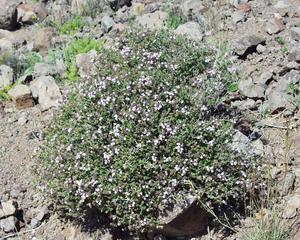
|
Thyme |
5-11
Perennial
Full sun
Dry, Moist
Light (sandy), Medium
Evergreen
0.1-0.3m
Herbs
true
Flowers, Leaves, Shoots
https://en.wikipedia.org/wiki/Thymus_vulgaris
Medium
Garden thyme, Wild Thyme, Samon-phyu, Timo, Tomillo, Thym, Common thyme, German thyme, Thyme
Lamiaceae or Labiatae
Thymian
https://pfaf.org/User/Plant.aspx?LatinName=Thymus vulgaris
Baleares, France, Italy, Spain
Algeria, Belgium, Cuba, Czechoslovakia, Dominican Republic, Haiti, Leeward Is., New Zealand South, Puerto Rico, Switzerland
0.3
https://powo.science.kew.org/taxon/urn:lsid:ipni.org:names:461765-1
Condiment, Tea
Deodorant, Disinfectant, Essential Oil, antifungal, Fragrance, Dynamic accumulator, Ground cover
|
Thyme (Thymus vulgaris) is a perennial herb that is native to the Mediterranean region. It has small, grey-green leaves and tiny, pink or purple flowers. The stems are woody and the plant grows to be about 30 cm tall. Thyme prefers well-drained, sandy soil and full sun. It is a low-maintenance plant and can be grown easily in a garden or in containers. To cultivate it successfully, it is important to water it regularly, especially during dry periods, and to trim the plant regularly to promote new growth. Thyme is edible and both the leaves and flowers can be used in cooking. They can be dried or frozen for long-term storage. The leaves have a strong, pungent flavor and are often used in meat and vegetable dishes, as well as in teas and other beverages. In addition to its culinary uses, thyme also has several medicinal properties. It has been used to treat respiratory conditions, such as bronchitis and asthma, and is also believed to have antibacterial and antifungal properties. It can also be used as a natural insect repellent. Thyme is an attractive plant that is valuable for wildlife. It is a good source of nectar for bees and other pollinators. It is also an important food plant for the caterpillars of some butterfly species. Overall, thyme is a versatile and useful herb that can be grown easily in a variety of conditions. Its flavorful leaves and attractive flowers make it a valuable addition to any garden or farm. |
Show
Edit |
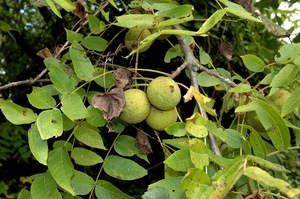
|
Black walnut |
4-9
Perennial
Full sun
Moist
Light (sandy), Medium, Heavy (clay)
30.0
Tall trees
Crafting, Compost, Dye, Filter, Herbicide, Pest control, oil, Tannin, Lumber, Dynamic accumulator, Fragrance
true
Sap, Seed
https://en.wikipedia.org/wiki/Juglans_nigra
Fast
Juglandaceae
Schwarznuss
True
Oil, Sweetener
https://pfaf.org/User/Plant.aspx?LatinName=Juglans nigra
Alabama, Arkansas, Connecticut, Delaware, District of Columbia, Florida, Georgia, Illinois, Indiana, Iowa, Kansas, Kentucky, Louisiana, Maryland, Massachusetts, Michigan, Minnesota, Mississippi, Missouri, Nebraska, New Jersey, New York, North Carolina, Ohio, Oklahoma, Ontario, Pennsylvania, Rhode I., South Carolina, South Dakota, Tennessee, Texas, Virginia, West Virginia, Wisconsin
Austria, Belgium, Bulgaria, Czechoslovakia, Denmark, Germany, Hungary, Italy, New Mexico, North Caucasus, Poland, Romania, Tadzhikistan, Transcaucasus, Vermont, West Himalaya
https://powo.science.kew.org/taxon/urn:lsid:ipni.org:names:279034-2
|
Black walnut is a large deciduous tree native to North America, growing up to 100 feet tall. It has a straight trunk with a rough, deeply furrowed bark, and a canopy of large, pinnately compound leaves with 15-23 lance-shaped leaflets. The tree produces large, greenish-white flowers in the spring, followed by large, spherical fruits containing a single, edible nut. Black walnuts are prized for their distinctive, rich flavor and are commonly used in baking and cooking. The nuts can be harvested in the fall and can be stored in their shells for several months. Black walnuts prefer deep, well-drained soils and can tolerate a wide range of soil pH levels. They can be grown successfully in full sun to partial shade, and they are relatively drought-tolerant once established. Black walnuts are not particularly winter hardy, and they can be damaged by heavy ice and snow. In addition to their culinary uses, black walnuts have a number of other uses. The wood is highly prized for its durability and attractive grain, and is used in furniture making and other woodworking applications. The tree's leaves, bark, and nuts are also used in herbal medicine for their astringent and tonic properties. Black walnuts are also valued for their ability to improve soil health, as their deep taproots help to break up compacted soils and their fallen leaves add organic matter to the soil. Black walnuts are also an important food source for wildlife, including squirrels, birds, and deer. The tree provides shelter and nesting sites for a variety of animals, and its fallen leaves and nuts provide food for many species. |
Show
Edit |
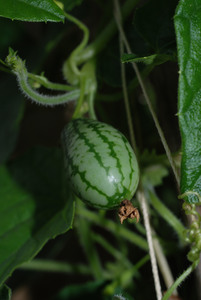
|
Cucamelon |
Annual
Full sun
Vines
Seed - direct sow, Seed - transplant
1 week after last frost
https://en.wikipedia.org/wiki/Melothria_scabra
Cucamelon, Mexikanische mini-gurke
60-70
23cm, 60cm
6.5-7.0
15-30°c (60-85°f)
Mouse melon
Cucurbitaceae
-3
67
Colombia, El Salvador, Guatemala, Honduras, Mexico Central, Mexico Northeast, Mexico Northwest, Mexico Southeast, Mexico Southwest, Nicaragua, Panamá, Venezuela
3-4 weeks before last frost
At last frost
https://powo.science.kew.org/taxon/urn:lsid:ipni.org:names:293320-1
|
Corn, Sunflowers and any other high growing plant, can act as a trellis. #### Propagation Direct sow when soil temperatures reach 15°C (60°F). Plant inside 3-4 weeks before planting outside, and use bottom-heat to help germination. Transplant when plant develop their third true leaf. #### Links [Cucamelon @ West Coast Seeds](https://www.westcoastseeds.com/products/cucamelon) |
Show
Edit |

|
Allium cepa ascalonicum |
4-8
Full sun
Moist
Light (sandy), Medium
5.0-7.0
0.3
0.2
Herbs
25cm, 10inch
Seed - direct sow
mid-Nov. - mid-March
Flowers, Leaves, Root
Alliaceae, Liliaceae
https://en.wikipedia.org/wiki/Shallot
https://pfaf.org/User/Plant.aspx?LatinName=Allium cepa ascalonicum
Cosmetic, Dye, Hair, Polish, Rust
true
|
Easy to grow vegetable that grow from a bulb. Edible parts are used for cooking. Exists in many varieties. Grows well in any fertile, well-drained soil at a sunny spot. Is started from seeds or sets (immature bulbs). Has a long growing period. |
Show
Edit |

|
Papalo Quelite |
Leaves
antifungal
Herbs
10-11
Annual
Full sun, Partial sun/shade
Dry, Moist
Light (sandy), Medium, Heavy (clay)
5 feet
http://tropical.theferns.info/viewtropical.php?id=Porophyllum+ruderale
Asteraceae
Yerba Porosa, Quilquina, Bolivian Coriander, Papalo, Killi, Summer Cilantro
antiinflammatory; roots as pain relief from rheumatism and erysipelas
21°C (70°F)
7-21 days
Seed - direct sow, Seed - transplant
May and later
seed indoors and plant outside when 6 inch tall
Argentina Northeast, Argentina Northwest, Arizona, Aruba, Bahamas, Bolivia, Brazil North, Brazil Northeast, Brazil South, Brazil Southeast, Brazil West-Central, Cayman Is., Chile North, Colombia, Costa Rica, Cuba, Dominican Republic, Ecuador, El Salvador, French Guiana, Galápagos, Guatemala, Guyana, Haiti, Honduras, Jamaica, Leeward Is., Mexico Central, Mexico Gulf, Mexico Northeast, Mexico Northwest, Mexico Southeast, Mexico Southwest, Netherlands Antilles, New Mexico, Nicaragua, Panamá, Paraguay, Peru, Puerto Rico, Suriname, Texas, Trinidad-Tobago, Uruguay, Venezuela, Venezuelan Antilles, Windward Is.
China Southeast, Ivory Coast, Jawa, Lesser Sunda Is., Malaya, New Guinea, Queensland, Réunion
https://powo.science.kew.org/taxon/urn:lsid:ipni.org:names:208446-2
|
An annual native to Mexico through South America. Leaves are strongly aromatic and can be used as a seasoning. |
Show
Edit |
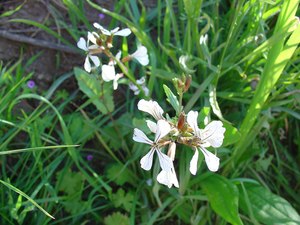
|
Rocket |
6-9
Annual
Full sun, Partial sun/shade
Dry, Moist
Light (sandy), Medium, Heavy (clay)
0.6
Flowers, Leaves
Seed - direct sow, Seed - transplant
Fast
Brassicaceae or Cruciferae
Oil, Condiment
https://pfaf.org/User/Plant.aspx?LatinName=Eruca vesicaria sativa
in spring
25°C
1-3 days
start indoors in pots at a depth
Arugula
Rucola
0.3
oil
true
|
Rocket, also known as Eruca vesicaria sativa, is a plant native to the Mediterranean region. It is a small, annual plant that typically grows to be about 20-30 cm tall. It has long, narrow leaves that are a pale green color, and small white or yellow flowers. The plant grows quickly and can be differentiated from similar plants by its unique leaf shape. Leaves can be harvested after 3-6 weeks. Rocket prefers to grow in well-drained soil in full sun or partial shade. It likes to grow along tracks, on waste grounds or stony places. To cultivate it successfully, a grower will need to ensure that the soil is moist but not waterlogged, and will also need to protect the plant from extreme temperatures, especially frost. Rocket is not particularly winter hardy, so it may need to be grown in a greenhouse or indoors in colder climates. Rocket is edible, and both the leaves and the seeds can be eaten. The leaves have a spicy, peppery flavor and can be used in salads or cooked dishes. The seeds ripen from July to September and can be roasted and used as a flavoring for dishes or as a garnish. After harvest, the leaves can be stored in the refrigerator for a few days, while the seeds can be stored in an airtight container in a cool, dry place for several months. Rocket has several uses beyond its edible parts. It has been used medicinally as a digestive aid and to treat respiratory problems. Rocket is also valuable for wildlife, as it provides food and shelter for a variety of species. Its flowers attract pollinators such as bees and butterflies, and its seeds are a source of food for birds |
Show
Edit |

|
Nane |
Nana-minze
Afghanistan, Alaska, Albania, Alberta, Algeria, Altay, Amur, Angola, Arizona, Arkansas, Austria, Azores, Baleares, Baltic States, Belarus, Belgium, Botswana, British Columbia, Bulgaria, Buryatiya, California, Cambodia, Canary Is., Cape Provinces, Cape Verde, Central European Rus, Chad, Chatham Is., China North-Central, China South-Central, China Southeast, Chita, Colorado, Connecticut, Corse, Cyprus, Czechoslovakia, Delaware, Denmark, East Aegean Is., East European Russia, Egypt, Ethiopia, Finland, Florida, France, Free State, Føroyar, Georgia, Germany, Great Britain, Greece, Hungary, Iceland, Idaho, Illinois, India, Indiana, Inner Mongolia, Iowa, Iran, Iraq, Ireland, Irkutsk, Italy, Japan, Jawa, Kamchatka, Kansas, Kazakhstan, Kentucky, Kenya, Khabarovsk, Kirgizstan, Korea, Krasnoyarsk, Kriti, Krym, Kuril Is., KwaZulu-Natal, Labrador, Laos, Lebanon-Syria, Lesotho, Lesser Sunda Is., Libya, Madeira, Magadan, Maine, Malawi, Malaya, Maluku, Manchuria, Manitoba, Maryland, Massachusetts, Mexico Central, Mexico Northeast, Mexico Northwest, Michigan, Minnesota, Missouri, Mongolia, Montana, Morocco, Myanmar, Namibia, Nebraska, Nepal, Netherlands, Nevada, New Brunswick, New Hampshire, New Jersey, New Mexico, New South Wales, New York, New Zealand North, New Zealand South, Newfoundland, North Caucasus, North Dakota, North European Russi, Northern Provinces, Northern Territory, Northwest European R, Northwest Territorie, Norway, Nova Scotia, Ohio, Oklahoma, Ontario, Oregon, Pakistan, Palestine, Pennsylvania, Philippines, Poland, Portugal, Primorye, Qinghai, Queensland, Québec, Rhode I., Romania, Rwanda, Sakhalin, Sardegna, Saskatchewan, Saudi Arabia, Sicilia, Sinai, South Australia, South Dakota, South European Russi, Spain, Sri Lanka, Sudan, Sulawesi, Sumatera, Svalbard, Swaziland, Sweden, Switzerland, Tadzhikistan, Tanzania, Tasmania, Tennessee, Texas, Thailand, Tibet, Transcaucasus, Tunisia, Turkey, Turkey-in-Europe, Turkmenistan, Tuva, Uganda, Ukraine, Utah, Uzbekistan, Vermont, Victoria, Vietnam, Virginia, Washington, West Himalaya, West Siberia, West Virginia, Wisconsin, Wyoming, Xinjiang, Yakutskiya, Yugoslavia, Yukon, Zambia, Zimbabwe
Alabama, Amsterdam-St.Paul Is, Argentina Northeast, Argentina Northwest, Argentina South, Bangladesh, Bermuda, Bolivia, Brazil South, Caroline Is., Chile Central, Chile North, Chile South, Colombia, Comoros, Costa Rica, Cuba, District of Columbia, Dominican Republic, Eritrea, Falkland Is., Fiji, Galápagos, Gambia, Gilbert Is., Gulf of Guinea Is., Haiti, Hawaii, Juan Fernández Is., Louisiana, Marianas, Mauritania, Mexico Southwest, Mississippi, Niger, Norfolk Is., North Carolina, Oman, Prince Edward I., Puerto Rico, Society Is., South Carolina, St.Helena, Trinidad-Tobago, Tristan da Cunha, Uruguay, Venezuela
https://powo.science.kew.org/taxon/urn:lsid:ipni.org:names:30016176-2
|
Show
Edit |